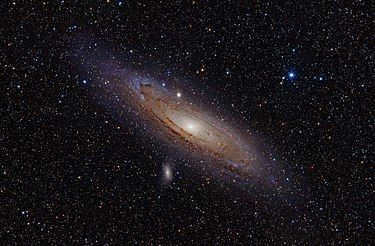

The Andromeda Galaxy or Andromeda Nebula (M 31, NGC 224) is a spiral galaxy of the Sb type. This galaxy, which is the closest large galaxy to the Milky Way, can be found in the constellation Andromeda and is located at a distance of 772 kiloparsecs [1] (equivalent to 2.52 million light-years) from us. The galaxy’s plane is inclined to our perspective at an angle of 15 degrees, and its apparent size measures 3.2 × 1.0 degrees [2]. It has an apparent stellar magnitude of +3.4 m.
Observational history
The Andromeda Galaxy was first mentioned in the “Catalog of Fixed Stars” by the Persian astronomer As-Sufi (946), who referred to it as a “small cloud” [3]. The initial observations of the object through a telescope were recorded by the German astronomer Simon Marius in 1612. Charles Messier mistakenly credited Marius with the discovery and included the object in his famous catalog as M 31. In 1785, William Herschel observed a faint red spot at the center of M 31. He mistakenly believed that the galaxy was the closest among all nebulae and calculated its distance (which was completely incorrect) to be equivalent to 2000 times the distance between the Sun and Sirius [4].
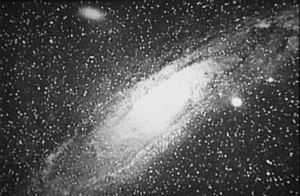
Back in 1864, William Huggins made an interesting discovery while studying the spectrum of M 31. He noticed that it was unlike the spectra of gas-dust nebulae, suggesting that M 31 was made up of individual stars. Huggins’ assumption about the stellar nature of M 31 was later confirmed through further research.
Another significant event occurred in 1885 when a supernova, named SN 1885A or S Andromeda, erupted in the galaxy. This remains the only recorded supernova event in the history of observations of M 31.
The Welsh astronomer Isaac Roberts obtained the first photographs of the galaxy in 1887. Utilizing his personal observatory in Sussex, he captured images of M 31 and made the groundbreaking discovery of its spiral structure [6]. However, during this period, it was still widely believed that M31 was part of our own Milky Way galaxy, and Roberts mistakenly interpreted it as another solar system with developing planets.
The radial velocity of the galaxy was later determined by American astronomer Vesto Slifer in 1912. By conducting spectral analysis, he calculated that M 31 was moving towards the Sun at an unprecedented speed for astronomical objects known at that time – approximately 300 km/s [7].
Key features

Movement within the Local Group
Similar to the Milky Way, the Andromeda Galaxy is a member of the Local Group and is currently moving towards the Sun at a velocity of 300 km/s, resulting in a violet-shifted appearance. By analyzing the Sun’s motion within the Milky Way, scientists have determined that the Andromeda Galaxy and our own Galaxy are approaching each other at a rate of 100-140 km/s [9]. Consequently, the collision between these two galactic systems is expected to occur in approximately 3-4 billion years. Should this event transpire, it is anticipated that the two galaxies will merge into a singular, larger galaxy. As a result of powerful gravitational disturbances, there is a possibility that our solar system will be expelled into intergalactic space. However, it is unlikely that the destruction of the Sun and planets will transpire during this catastrophic event [10].
Composition
The Andromeda Galaxy, as confirmed by the Spitzer Space Telescope, is home to an astounding number of around one trillion stars [11]. With its vastness, it reigns as the largest galaxy within the Local Group. Additionally, it boasts a collection of dwarf satellites, including M 32, M 110, NGC 185, NGC 147, and potentially more. Notably, its length spans an impressive 260,000 light-years, making it 2.6 times longer than our very own Milky Way.
The nucleus
The nucleus of M 31, similar to many other galaxies (including our own Milky Way), harbors a potential supermassive black hole (SMBH). Scientific calculations have revealed that its mass surpasses 140 million times that of our Sun. In 2005, the Hubble Space Telescope made a perplexing discovery: a mysterious disk consisting of young, blue stars enveloping the SMBH. These stars revolve around the relativistic entity, much like planets orbiting the Sun. Astronomers were confounded by the formation of such a donut-shaped disk in such close proximity to an immensely massive object. According to calculations, the immense tidal forces exerted by the SMBH should prevent the condensation of gas-dust clouds and the subsequent formation of new stars. Further observations may offer valuable insights into this enigma.
During the investigation of the core of M 31 using the XMM-Newton Space Telescope, a group of European scientists has discovered 63 distinct X-ray sources. Among these sources, the majority (46 objects) have been identified as low-mass X-ray double stars, while the remaining sources are potential neutron stars or black holes in double systems [13].
Additional items
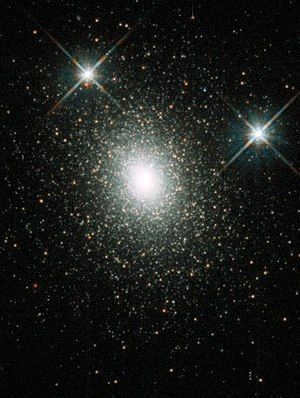
Around 460 globular clusters have been documented within the galaxy [14]. The most massive of these is known as Mayall II, or G1, and it possesses the highest luminosity within the Local Group, surpassing even the brightest cluster in the Milky Way, Omega Centauri [15]. Located approximately 130 thousand light-years away from the center of the Andromeda Galaxy, Mayall II is home to at least 300 thousand ancient stars. Its structure and the stars it contains, which belong to various populations, suggest that it may be the remnant core of an ancient dwarf galaxy that was once engulfed by M31 [16]. Studies have indicated the presence of a black hole candidate with a mass equivalent to 20 thousand Suns at the center of this cluster [17]. Similar objects can also be found in other clusters:
In 2005, a brand-new type of star cluster was identified in the halo of M 31 by astronomers. These three recently discovered clusters consist of numerous bright stars, almost as many as globular clusters. However, what sets them apart from globular clusters is their larger size – spanning several hundred light-years – and lower mass. The distances between stars within these clusters are also much greater. It is likely that they represent a transitional category of systems between globular clusters and dwarf spheroidal galaxies[18].
Additionally, within this galaxy, there is a star called PA-99-N2, which is orbited by an exoplanet. This exoplanet is the first to be detected outside of the Milky Way [19].
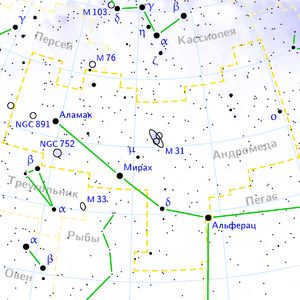
Fall to winter is the optimal time to observe the Andromeda Nebula. When away from the bright lights of the city, even inexperienced observers can see the glowing oval shape of M 31 with their naked eye near ν And. This nebula is the farthest object visible to the naked eye from Earth. Due to the finite speed of light, we see it as it appeared 2.5 million years ago. It’s important to note that 2.5 million years ago, there were no modern humans on Earth. However, according to the Special Theory of Relativity, we cannot determine the current appearance of this galaxy as what we see is our present moment.
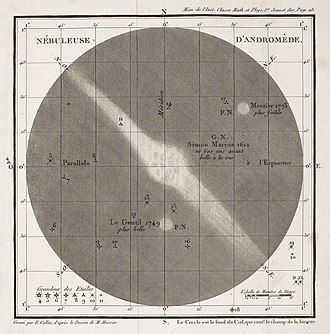
Even in urban areas with bright city lights, the galaxy can still be seen through binoculars. However, when observed with amateur telescopes of medium aperture (150-200 mm), the results are often underwhelming. Even on a clear, moonless night, the galaxy appears as a large, glowing ellipsoid with indistinct edges and a bright center. A careful observer may notice a couple of dusty lanes on the northwestern side of the galaxy (the side closest to us) and a small area of increased brightness in the southwest (which is actually a massive star-forming region within the M 31 nebula). Apart from these features, there is not much else that can be observed, except for two companion satellites – the small elliptical galaxies M32 and M110. It is impossible to see the vibrant colors and intricate details depicted in popular publications using an amateur telescope.
The reason for this phenomenon lies in the unique characteristics of human night vision. Despite our eyes’ impressive sensitivity to light, they are unable to accumulate light over an extended period of time, unlike modern photodetectors. Additionally, our eyes sacrifice color recognition and experience a significant decrease in visual acuity in order to achieve night sensitivity. Consequently, when observing diffuse objects in deep space, we are only able to perceive fuzzy, light gray objects against a dark gray background. Compounding this issue is the immense size of M31, which further diminishes its contrasts and level of detail.
How to locate a galaxy in the night sky
If one struggles to find a galaxy on their own but is familiar with the major constellations, they can use the following method. Firstly, locate Polaris (also known as α of the Little Bear, the last star of the handle of the “Little Dipper”). Next, find Cassiopeia. Within Cassiopeia, locate the brightest star, α Cassiopeia (the second lower corner if Cassiopeia appears as a W). Then, mentally draw a line between these two stars. The galaxy M 31 will be situated along this line, appearing as a blurred ellipse once the line extends past Cassiopeia. [source not provided for 57 days]
- The Andromeda Nebula has two satellites, M 32 and M 110
- M 33 is a large spiral galaxy located in the Triangle constellation, to the south of β And
- M 76 is a small planetary nebula called “Little Dumbbell” and is located to the northeast, in the constellation Perseus
- M 34 is a relatively bright scattered cluster and can be found to the east, also in the constellation Perseus
Messier Marathon observing sequence
Notes
- ↑ 12 I. Ribas, C. Jordi, F. Vilardell, E.L. Fitzpatrick, R.W. Hilditch, F. Edward (2005). "First Determination of the Distance and Fundamental Properties of an Eclipsing Binary in the Andromeda Galaxy". Astrophysical Journal635: L37-L40. DOI:10.1086/499161.
- ↑The Andromeda Galaxy (M 31) (English) . Observing at Skyhound. Archived from the original source on February 4, 2012.Checked October 14, 2011.
- ↑ C. Weinberg. "The first three minutes. A modern view on the origin of the Universe. – Izhevsk, SIC "Regular and Chaotic Dynamics", 2000, p. 28
- ↑Herschel, Esq.On the Creation of the Universe. (English) . Phil. Trans. R. Soc. Lond. January 1, 1785 75:213-266 (January 1, 1785). Stored in the archives as of August 24, 2011.Verified on June 30, 2009.
- ↑William HugginsOn the Analysis of the Nebulae Spectra. (English) . Phil. Trans. R. Soc. Lond. January 1, 1864 154:437-444 (January 1, 1864). Stored in the archives as of August 24, 2011.Verified on June 30, 2009.
- ↑Roberts, IsaacA Collection of Photos of Stars, Star-clusters and Nebulae, Vol. II (English) . London: The Universal Press (1899). Stored in the archives as of August 24, 2011.Verified on October 4, 2009.
- ↑Slipher, V. M.The radial velocity of the Andromeda Nebula (English) . Lowell Observatory Bulletin, vol. 1, pp.56-57 (1913). Archived from the original source on August 24, 2011.Checked June 30, 2009.
- ↑Wonders of black holes revealed gerrymandering in the cores of galaxies
- ↑Tariq MalikCrash Course: Simulating the Destiny of Our Milky Way . Space.com (May 07, 2002). (unavailable link -. history) Checked June 16, 2009.
- ↑Fraser CainWhen Our Galaxy Collides With Andromeda, What Will Happen to the Sun? . Universe Today (May 10th, 2007). Archived from the original source on August 24, 2011.Checked June 16, 2009.
- ↑The Andromeda galaxy is home to a trillion stars.
- ↑Dolores Beasley, Susan Hendrix, Donna WeaverHubble Telescope Discovers Enigmatic Ring of Blue Stars Surrounding Black Hole. An official press release on the Hubble Telescope’s website (September 20, 2005). Archived from the original source on August 24, 2011.Checked on June 16, 2009.
- ↑Barnard, R.; Kolb, U.; Osborne, J. P..Measuring the Bright X-ray Population of the Core of M31 using XMM-Newton . Arxiv.org (08/2005). Checked on June 17, 2009.
- ↑PAULINE BARMBY AND JOHN P. HUCHRA31 Globular Clusters in the Hubble Space Telescope Archive. I. Cluster Detection and Completeness . The Astronomical Journal, 122:2458-2468, 2001 (2001 July 19). Archived from the original source on August 24, 2011.Checked on June 17, 2009.
- ↑Hubble Telescope Observes Globular Cluster in Nearby Galaxy. A press release was published on the official website of the Hubble Telescope on April 24, 1996. This information is archived from the original source, which was accessed on August 24, 2011.Verification was conducted on June 17, 2009.
- ↑G. Meylan, A. Sarajedini, P. Jablonka, S. G. Djorgovski, T. Bridges, R. M. RichMayall II = G1 in M31: Is it a Giant Globular Cluster or the Core of a Dwarf Elliptical Galaxy? (English). The article is available on Arxiv.org (May 1, 2001). Verification was conducted on June 17, 2009.
- ↑Karl Gebhardt, R. Michael Rich, Luis HoA 20 Thousand Solar Mass Black Hole in the Stellar Cluster G1 (Engl.). The article is available on Arxiv.org (September 16, 2002). Verification was conducted on June 17, 2009.
- ↑A. P. Huxor, N. R. Tanvir, M. J. Irwin, R. Ibata, J. L. Collett, A. M. N. Ferguson, T. Bridges, G. F. LewisA fresh assortment of expansive, radiant stellar groups in the outer region of M 31 . Arxiv.org (9 Dec 2004). Verified June 17, 2009.
- ↑G. Ingrosso, S. Calchi Novati, F. De Paolis, Ph. Jetzer, A.A. Nucita, A.F. ZakharovPixel-lensing as a method to identify exoplanets in M 31 . Arxiv.org (5 Jun 2009). Verified June 16, 2009.
- ↑Messier's Depictions of M31/32/110 and M42/43. Archived from the primary source on August 24, 2011.Verified December 31, 2009.
References
- English and French information sourced from the original New General Catalog
- English information sourced from the Revised New General Catalog
- SIMBAD
- VizieR
- NASA/IPAC Extragalactic Database (English)
- List of publications dedicated to NGC 224
- M 31 listed in the Messier catalog on the SEDS website (English)
- M 31: Andromeda Nebula
- M 31: Another photograph of the galaxy
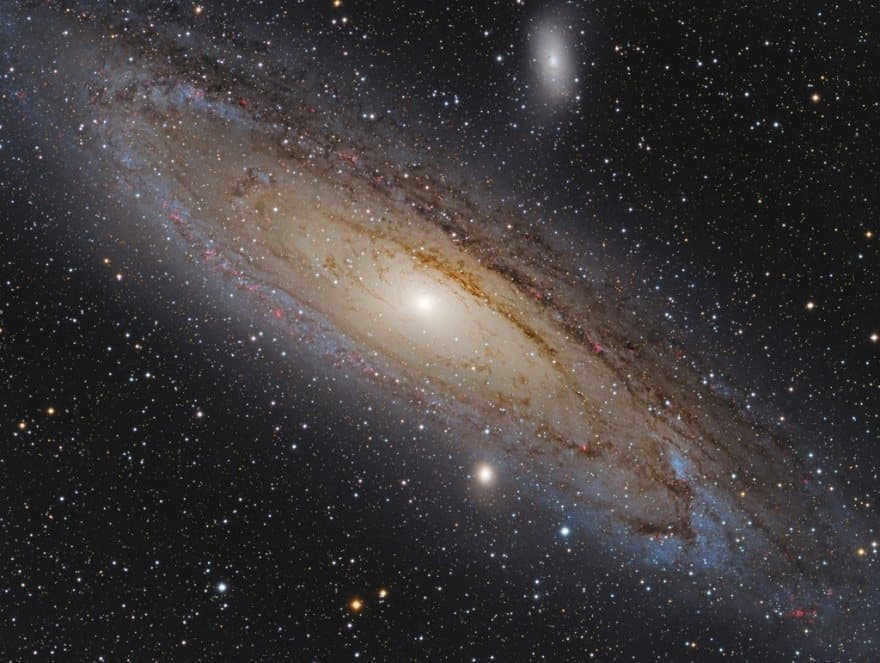
The Andromeda galaxy, also known as M 31, is a spiral galaxy located 2.54 light-years away from the Milky Way. It can be found in the constellation of Andromeda and is the closest galaxy to our own. The apparent magnitude of the Andromeda galaxy is 3.44, making it visible to the naked eye.
Andromeda galaxy in Messier’s catalog: a detailed overview
August 3, 1764
An exquisite belt-shaped nebula known as Andromeda, resembling a spindle, was examined by Charles Messier using various instruments, yet he never classified it as a star. Visually, it appears as two light pyramids with their axes pointing from northwest to southeast. The two light peaks are approximately 40 arcminutes apart, and the total base of the pyramids measures around 15 arcminutes. This nebula was initially discovered by Simon Marius and has been studied by numerous astronomers. Le Gentil even created a drawing of the nebula, which was published in the Academy’s Memoirs in 1759 on page 453 (with a diameter of 40 arcminutes).
In addition, Flammarion mentions that Messier personally added information about the M 31 nebula to his catalog, stating: “I utilized various instruments, including an exceptional 30-foot Gregorian telescope, a large six-inch mirror, and a 104x magnifier. With a fair amount of confidence, I can assert that there are no stars of any kind within the center of this nebula. The light gradually diminishes until it completely fades away.” Previous measurements have been conducted using a 4.5-foot Newtonian telescope equipped with a silk micrometer string.
| Study History | |
| Known since ancient times | |
| M 31, NGC 224 | |
| Observational Data | |
| Spiral galaxy | |
| 00 h 42.8 m | |
| 41° 16′ | |
| 3.2 × 1.0° | |
| Andromeda | |
| Physical Characteristics | |
| 110,000 light years. | |
Andromeda, a Greek princess, was once bound to a rock by her parents as an offering to a sea monster in order to protect their kingdom. However, Perseus came to her rescue and saved her from this fate. The Andromeda Galaxy is easily identifiable as it is a luminous object located near two well-known star patterns: the Great Square of Pegasus and Cassiopeia. It is only surpassed in brightness by Messier 45 and Messier 7.
The Andromeda Galaxy is considered one of the most distant celestial objects that can be observed without the aid of technology. The best time to view it is from October to December. By using 10 x 50 binoculars, one can spot the nucleus within the elliptical cloud. Larger telescopes allow for a view of the entire galaxy. Additionally, its brightest satellites, Messier 32 and Messier 110, can also be seen.
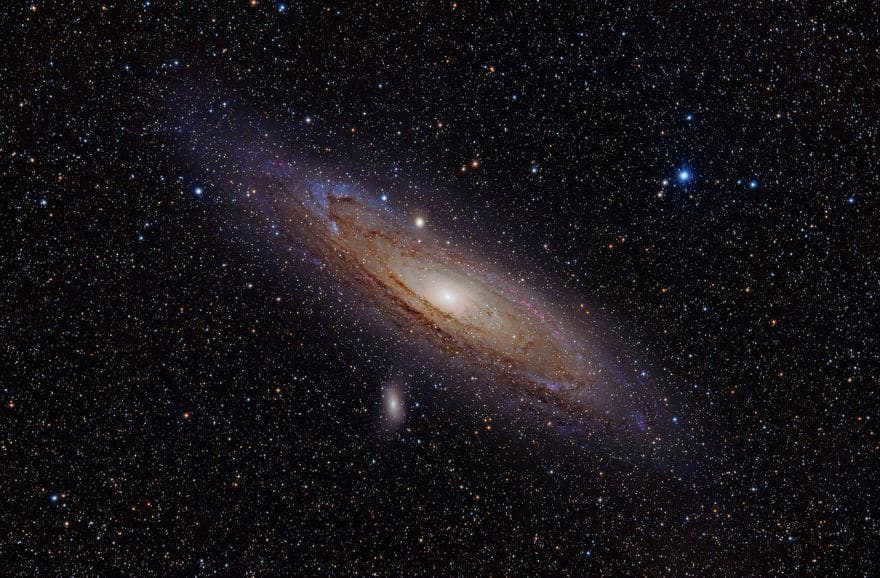

You are witnessing the presence of the Andromeda spiral galaxy, positioned 2.5 million light-years away. M32, M110, and the star Nu Andromeda are also identified in this depiction. The image was captured using an alpha hydrogen filter.
M31 holds the distinction of being the largest and most massive constituent of the Local Group, which encompasses our own galaxy, Messier 33, and 40 other galaxies. Andromeda surpasses the Milky Way in size and is home to a trillion stars. In approximately 3.75 billion years, these two galaxies will collide, giving rise to a new elliptical or disk galaxy.
There are approximately 14 satellite galaxies surrounding Andromeda. It is thought that Andromeda had a previous collision with M 32, resulting in the loss of its stellar disk and triggering the formation of stars in its center. However, this activity came to an end recently.
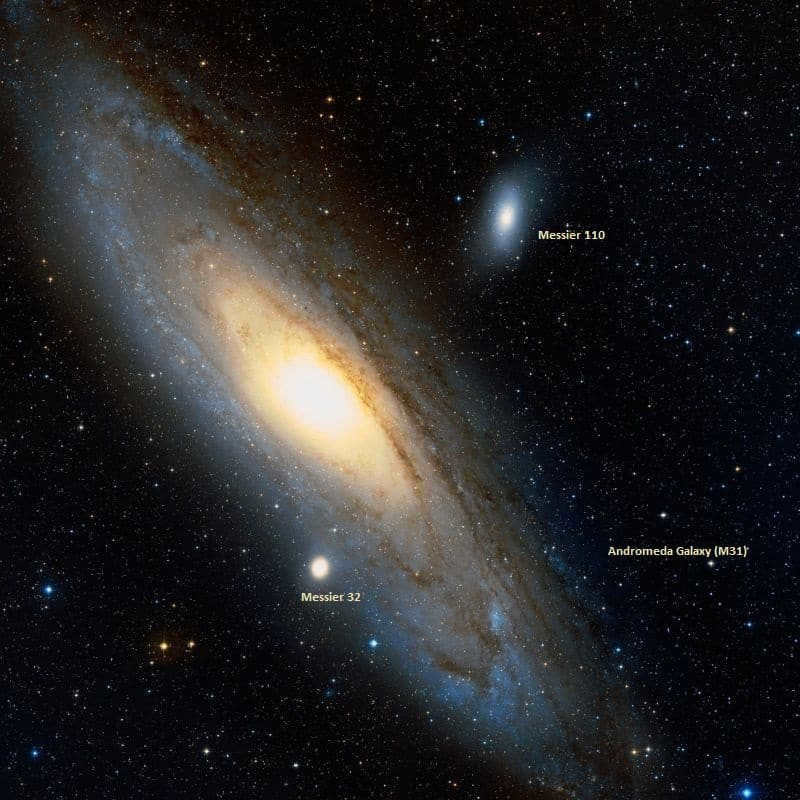
For centuries, scientists believed that the Andromeda galaxy was actually a nebula and was a part of our own galaxy. However, in 1917, doubts began to arise when astronomer Heber Curtis discovered a galaxy within the Andromeda nebula. Curtis observed 11 new stars in the galaxy and noticed that they were much fainter than other objects in the surrounding region. He determined that these stars were actually 500,000 light years away, which indicated that the Andromeda nebula was in fact a separate galaxy.
Curtis swiftly gave his support to a fresh idea positing that the spiral nebulae were distinct and whole galaxies. This concept was known as the “island universes” hypothesis (a phrase coined by Immanuel Kant). In 1920, Curtis took part in the Great Debates, during which he engaged in a discussion with Harlow Shapley regarding the nature of spiral nebulae and the size of the universe. Shapley believed that the universe was solely represented by our galaxy, while Curtis argued in favor of the existence of multiple galaxies.
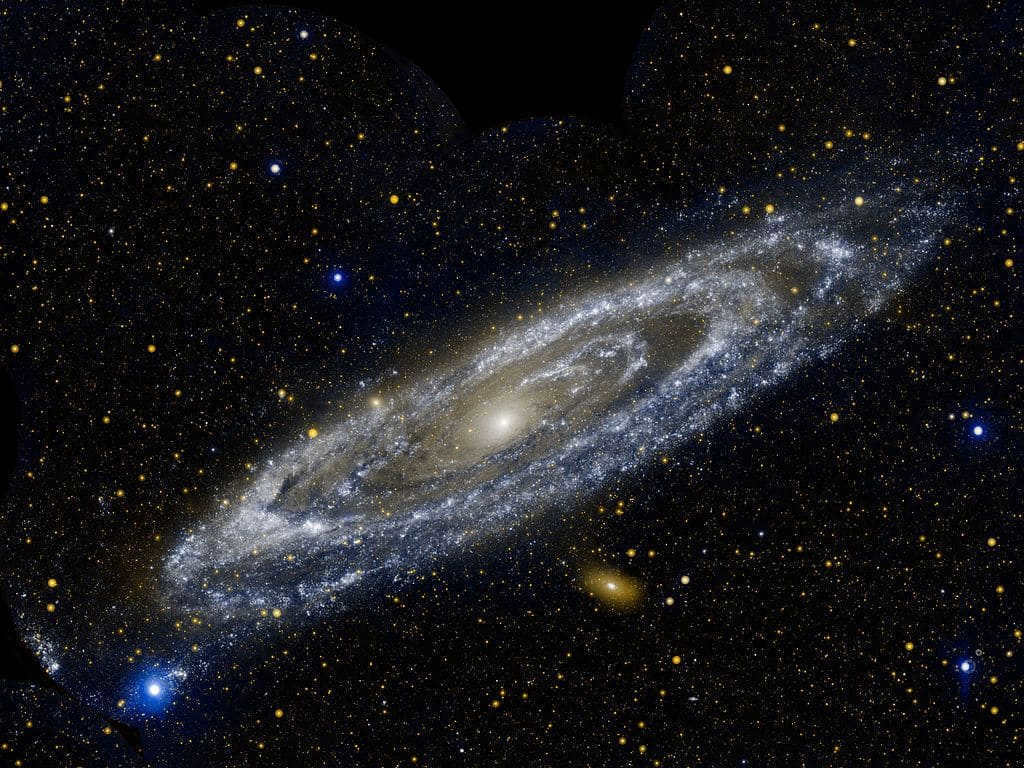
Up until 1923, the true essence of the Andromeda galaxy remained a mystery to mankind. It was not until the brilliant mind of Edwin Hubble came along that we were able to accurately calculate the vast distance between us and our celestial neighbor. Hubble achieved this feat by studying variable Cepheids that exist beyond the confines of our own galaxy. The initial calculations revealed that Andromeda is situated a staggering 750,000 light years away.
It was not until 1943 that Walter Baade made a groundbreaking discovery by resolving individual stars within Andromeda. Baade also made the distinction between two distinct populations within the galaxy: type I and type II. He theorized that each population would possess a unique variation of Cepheid, thus doubling the estimated age of the majestic M31.
The Encounter of the Andromeda Galaxy and the Milky Way
It might come as a surprise, but in the far-off future, a momentous event is set to occur – the Andromeda Galaxy and the Milky Way will collide. M 31 is currently hurtling towards us at a phenomenal speed of 110 kilometers per second. This extraordinary cosmic spectacle is projected to take place in approximately 4 billion years. Scientists speculate that prior to the ultimate fusion, our solar system will transition to a fresh territory within the boundaries of Andromeda.
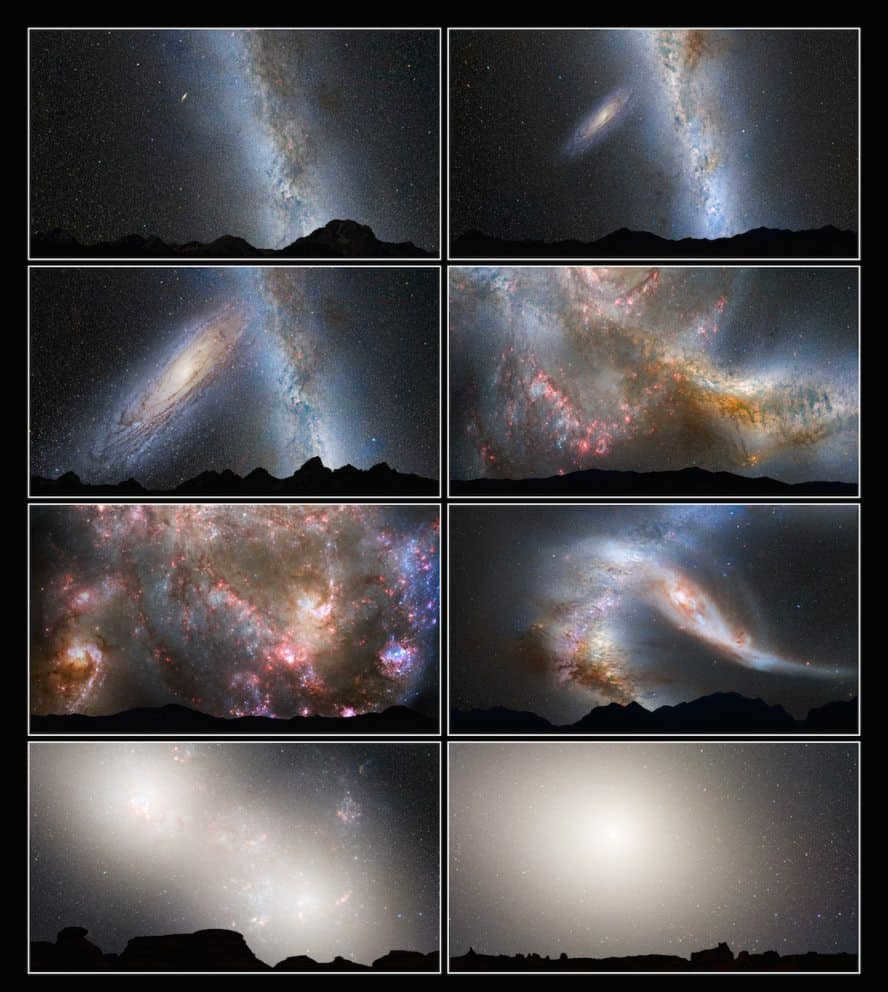

A sequence of pictures demonstrates speculation on the merging of the Milky Way with Andromeda
Andromeda Galaxy Trivia
Let’s explore some fascinating trivia about the Andromeda galaxy. M 31 materialized following the collision of two small galaxies approximately 5-9 billion years ago. In 2012, a recent study emerged, providing evidence that the event actually transpired 10 billion years ago, with protogalaxies being involved. As a result, a significant portion of the galaxy is abundant in metals, and an expanded disk was formed.
All of these factors resulted in the initiation of new star formation, leading to a period of enhanced brightness for M 31 that lasted for approximately 100 million years. Presently, it is evident that the galaxy primarily emits infrared radiation, with an average luminosity equivalent to 100 billion times that of the Sun.
Approximately 2-4 billion years ago, a collision occurred between M 33 and M 31, which triggered a fresh wave of star formation in the Andromeda galactic disk and caused the outer disk of M 33 to become distorted. Notably, the gas disk in M 31 is observed to rotate in the opposite direction to the central region, which is densely populated with young stars.
The earliest known references to Andromeda date back to 964 and are attributed to Abdurrahman al-Sufi, who referred to it as the “Little Cloud.”
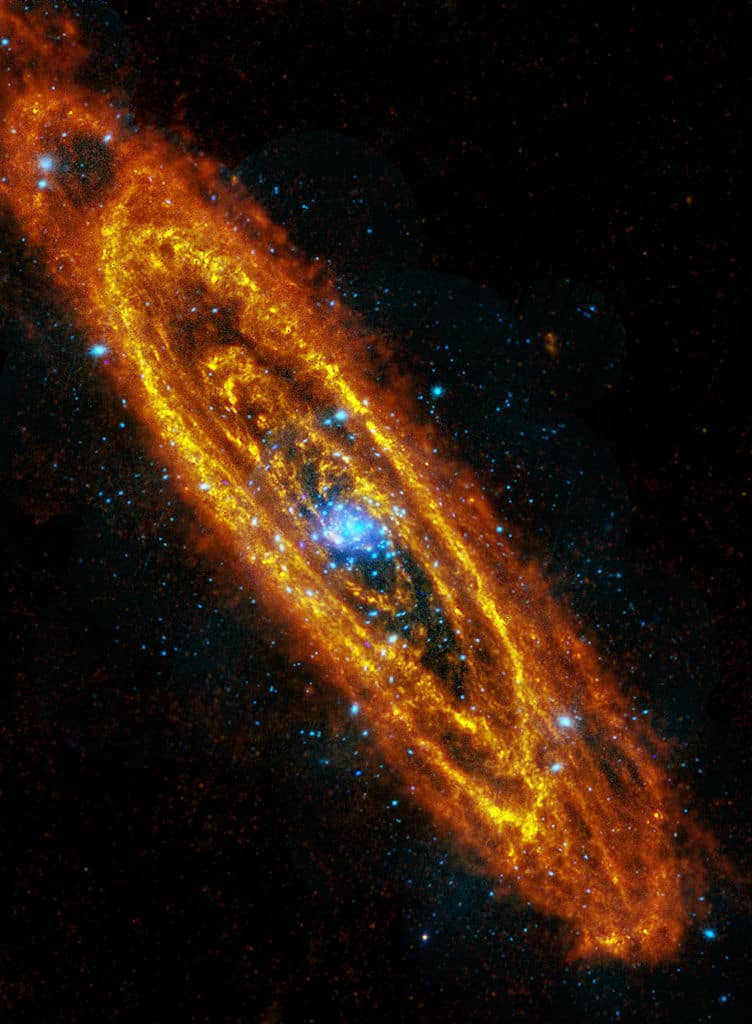
It showcases the dazzling stars of M31, alongside numerous rings of cooler stars. The image combines data from the Herschel Observatory in the infrared spectrum (orange) and the XMM-Newton telescope in X-ray wavelengths (blue).
Speaking of reports, the earliest records date back to December 15, 1612, when Simon Marius noted: “I appear to have come across a stationary star near the North Star in the Andromeda belt. Without employing any technique, it resembles a nebula. However, when viewed through a telescope, no stars are discernible. A faint glow spanning a quarter of a degree can be observed at its center. I cannot definitively confirm whether it is new or not.”
Charles Messier acknowledged that the credit for the discovery of M 31 should be given to Marius and he was unaware of the ancient observations made by the Persian astronomer. In his writings, Messier stated: “During the period of August 3-4, 1764, the observing conditions were excellent and I had the opportunity to closely examine the remarkable nebula first identified by Marius. I employed various instruments in my study, but the visibility of the stars within the nebula proved to be challenging. Notably, two distinct bright points, separated by an angular distance of 40 minutes, were observable. Over a span of 15 years, I diligently observed the nebula and recorded no discernible changes.”
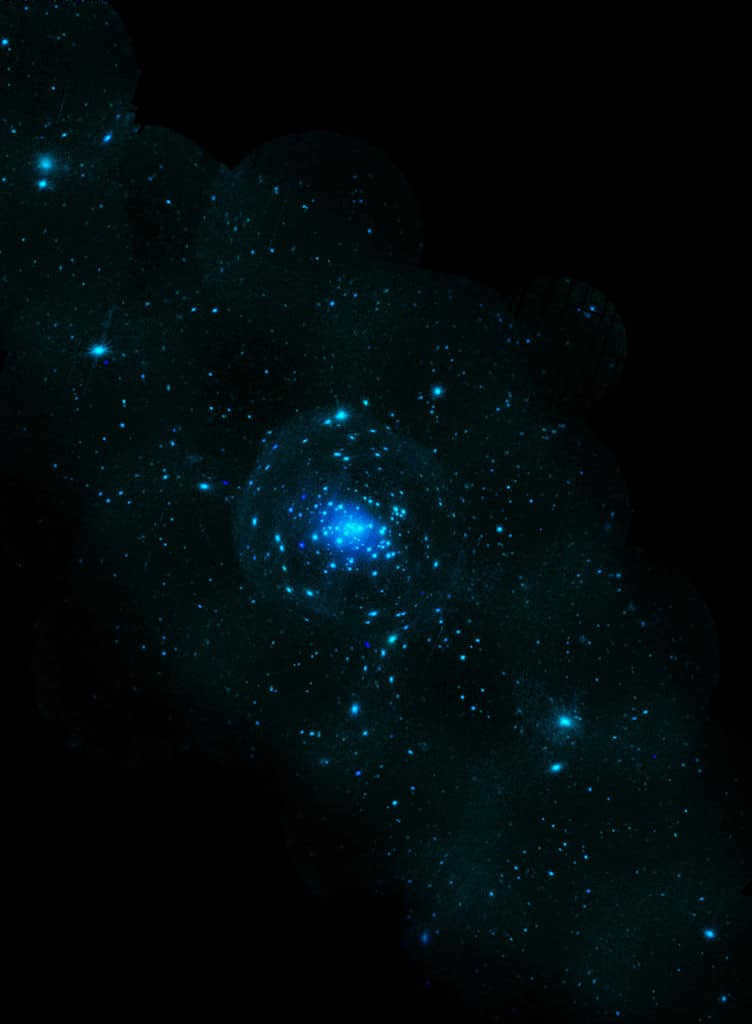
William Herschel first observed it on August 6, 1780. He believed it was much closer than it actually is, stating, “There is no doubt that the nebula in the Andromeda belt is the closest. It spans 16′ in diameter and exhibits a red glow in its brightest region. This serves as evidence that it is only 2000 times more distant than Sirius. In close proximity is M110, which was discovered by my sister Caroline on August 27, 1783.”
In September 1833, William Henry Smith wrote: "The nebula is located below the Andromeda belt and is surrounded by numerous telescopic stars. Under favorable weather conditions, it can be observed with the naked eye along an imaginary line from Alamac to Mirac. It is regarded as the oldest nebula, with mentions dating back as early as 905. Marius rediscovered it and reexamined it in 1612. He was struck by the peculiar nature of the phenomenon. He believed he saw a flickering candle flame, but Messier observed two cones or pyramids, with the center being brighter than the edges.
The satellite (Messier 32) was discovered in November 1749. It was identified by Guillaume Lejeantil, who added that the observed light was much dimmer. Messier observed it in 1764 and noted that no changes were detected. It has a nearly circular shape."
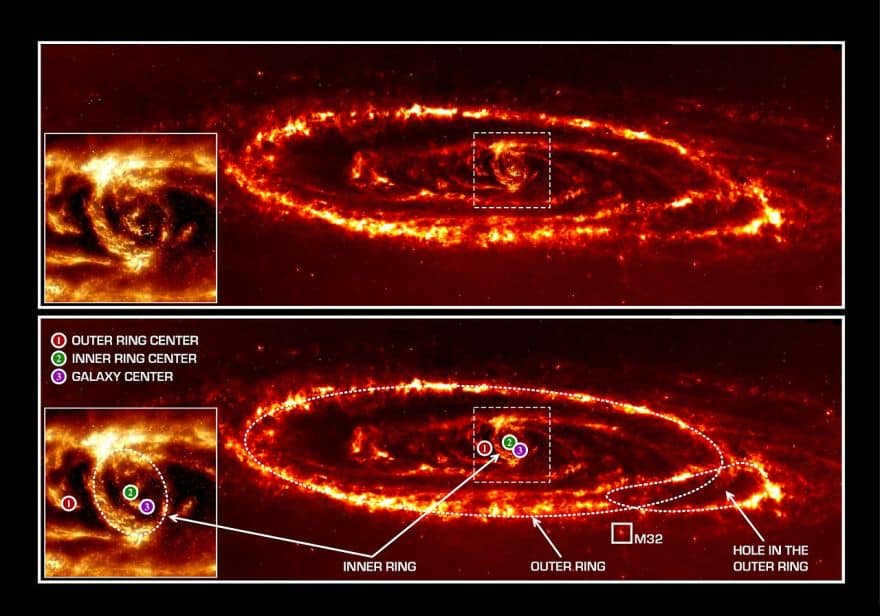
The researchers have discovered proof supporting the idea that M31 and M32 collided over 200 million years ago. Through infrared observations made by the Spitzer telescope, a dust ring located in the inner region was detected. When considering the outer ring as well, it becomes clear that M32 entered M31’s disk along the polar axis roughly 210 million years ago. The image was captured by the Infrared Imaging Camera (IRAC).
In 1834, William Haggis observed that the spectrum of M31 differed from that of a gas nebula, providing the first evidence of its stellar nature. The sole supernova, SN 1885A, was observed in 1885. At the time, it was believed that M31 was closer, so the event was initially labeled as Nova 1885. These objects are less bright than supernovae and exhibit nuclear explosions on the surface of a white dwarf in a binary system.
The initial photographs of the galaxy were captured by Isaac Roberts in 1887, showcasing its spiral arrangement. However, it was still referred to as a nebula at that time.
This particular galaxy stands out for hosting the most luminous globular cluster in the Local Group, known as G1, which is home to millions of stars. With an apparent magnitude of 13.72, it surpasses Omega Centauri in terms of brightness. G1 can be observed using a 10-inch telescope. Due to its mass and stellar population, some mistakenly identify it as the core of a dwarf galaxy.
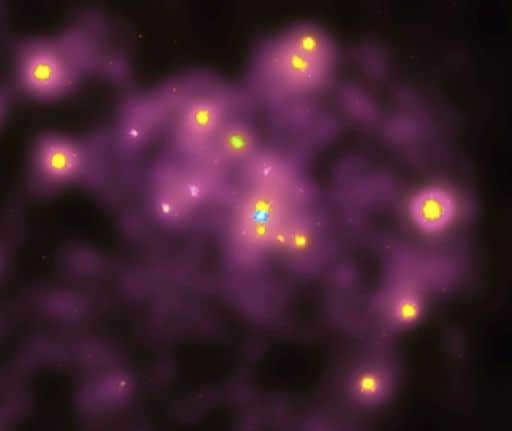
Generally, there exist 450 globular clusters within the Andromeda galaxy. G76 (located in the southwest) stands out among them due to its apparent brightness. Another massive globular cluster, 037-B327, was discovered in 2006 and shares similarities with G1 in terms of its properties.
One notable feature of the galaxy is the star cloud NGC 206, which was cataloged by William Herschel as H V.36 on October 17, 1786. The galaxy also possesses a prominent double nucleus, identified in 1991 by the Hubble telescope. The second nucleus could potentially belong to another galaxy or it may be an optical illusion caused by dust haze.
In 2012, the first extragalactic microquasar was detected within M 31. The signals emanated from a black hole with a mass 10 times that of the Sun. The Andromeda galaxy is frequently utilized in various works of science fiction.
The position of the Andromeda galaxy
Looking for the Andromeda galaxy in the night sky? No worries, it’s pretty easy to locate. Just look between two prominent star formations: the W in Cassiopeia and the Great Square of Pegasus. In the constellation Andromeda, there are a chain of stars that are connected. Alferac is the first one, followed by Delta Andromeda, Mirach, and Gamma Andromeda. M 31 is situated 8 degrees northwest of Mirach. You can spot it without any instruments.
Planets in the Andromeda Galaxy
In 2009, a potential planet was initially discovered in the Andromeda Galaxy. This discovery was made using the technique of gravitational microlensing, which allows for the detection of small celestial objects against the backdrop of larger ones. The planet was first observed in 2004 and was estimated to have a mass 6-7 times that of Jupiter. However, subsequent observations in 2009 revealed that it was more likely a star with a smaller companion.
There is a need to examine the characterization of M 31. The SA (s) b class is assigned to the Andromeda galaxy. These classifications are based on data gathered by 2MASS, which conducted a study of the celestial sphere between 1997 and 2001 using three different infrared wavelengths. It was observed by scientists that there exists a bar within the galaxy, confirming it as a spiral galaxy. In 2005, the discovery of a vast extended stellar disk with a diameter of 220,000 light-years was made.
The galaxy is positioned at an inclination of 77 degrees relative to us. Due to gravitational interaction, its originally flat disk has been deformed into an S shape. The spiral arms were initially investigated by Walter Baade, who determined that they are significantly wider in comparison to our own galaxy.
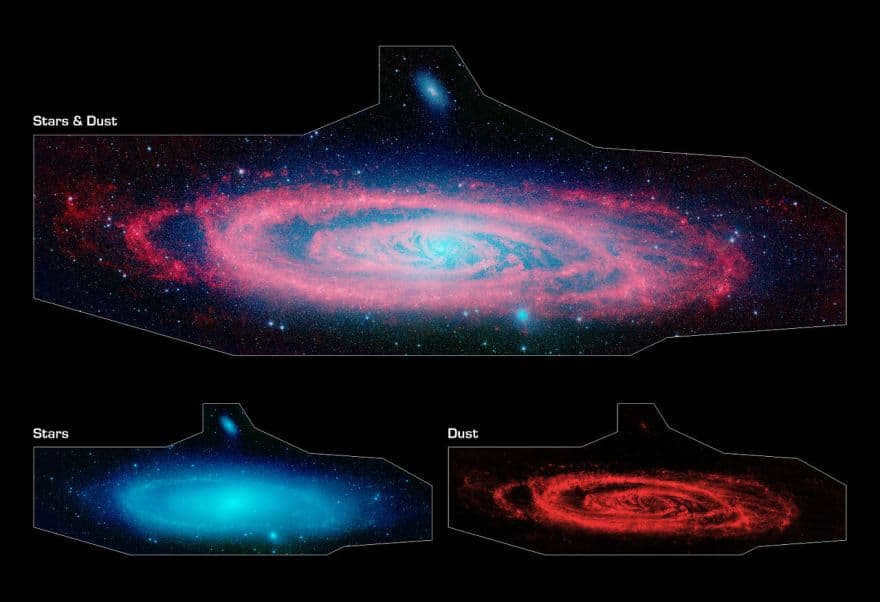
A careful examination has unveiled a characteristic spiral galaxy, with arms rotating in a clockwise direction. These arms are divided by a span of 13,000 light-years, and their arrangement is distorted due to gravitational interactions with M 32 and M 110.
Observations using infrared imaging in 1998 indicated that this particular galaxy may be classified as a ring galaxy. Within its internal structure, gas and dust have formed multiple rings, with one ring standing out as the most prominent. This specific ring is positioned at a distance of 32,000 light-years from the central nucleus and is clearly visible in images captured in the visible light spectrum. The spiral arms originate from a central bar and possess a segmented structure.
M 32 has traversed the disk of the Milky Way galaxy, resulting in the transfer of a significant portion of its mass. It is worth noting that the stars in the halo of the galaxy are not rich in metals. It is highly probable that both objects have undergone similar evolutionary phases: over a span of 12 billion years, each has successfully absorbed between 100-200 small galaxies.

The central region contains a compact cluster of stars. Within this region, there are two concentrations labeled P1 and P2, which are separated by a distance of 4.9 light-years. P2 is less bright and is located in the center, while P1 is brighter and positioned slightly off-center. P2 also harbors a black hole with a mass 140 million times that of the Sun.
Blue stars have a relatively short lifespan of around 200 million years and could have formed near the black hole during a period of intense star formation. Surrounding the small star cluster is a larger double core composed of evolved red stars arranged in an elliptical ring. The rotation speed of these stars decreases as their distance from the center increases.
In total, there are 35 black holes with masses comparable to stars in the Andromeda galaxy, with 7 of them located within 1,000 light-years of the central region. These black holes were formed through the collapse of massive stars and have a mass ranging from 5 to 10 times that of the Sun.
Examine a photograph of the Andromeda spiral galaxy (M 31) closely, or utilize our online telescopes and 3D models to observe the stars and constellations within the galaxy.
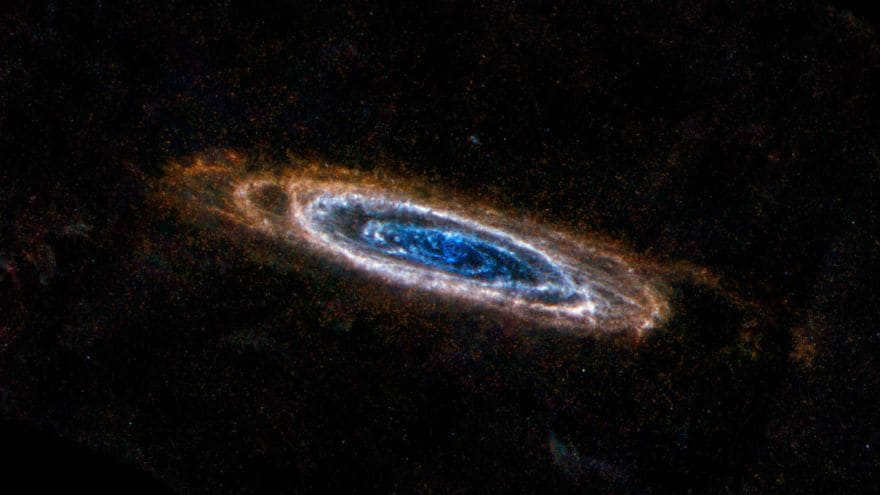

The Spitzer telescope has detected the presence of spiral arms within the ring, which stretch towards the central region. Stellar scattering can be observed within these arms, but only a few stars surrounded by dust cocoons are visible in infrared light. This is in contrast to images in visible light, which primarily capture starlight instead of dust. The central region of the galaxy is distinguished by a large bulge.
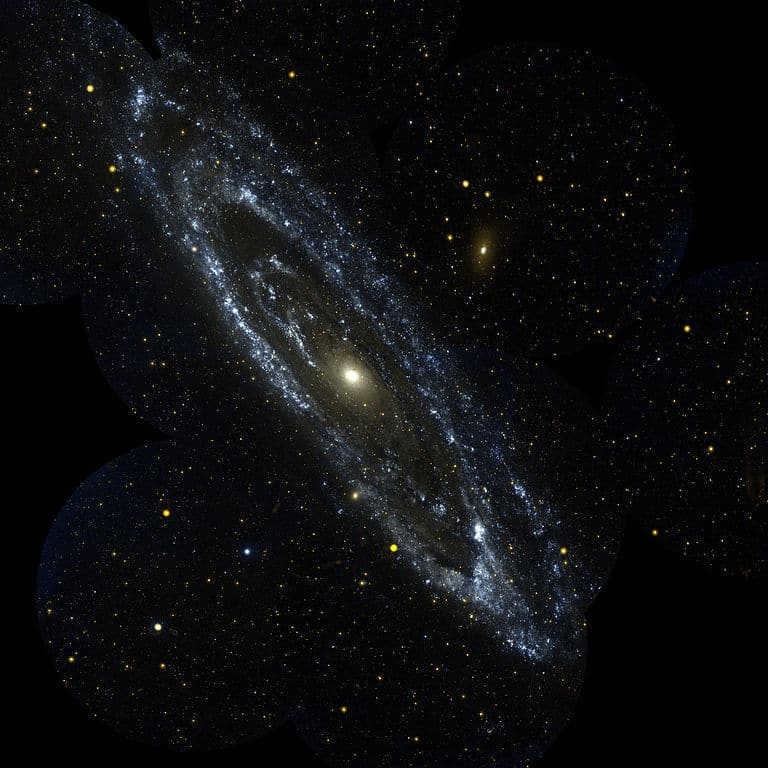
In the image from the Herschel Observatory, we can observe stunning circular patterns made of dust. These patterns are illuminated by the far-infrared spectrum, which allows us to analyze the coolest dust particles. The wavelengths of this spectrum range from 250 to 500 microns. Even at temperatures just a few degrees above absolute zero, we can clearly perceive these dark and dense dust clouds. Among the concentric rings, we can also spot prominences known as dust spokes. To enhance the viewer’s experience, the colors in the image have been adjusted. Colder clouds appear brighter and have a red hue, while warmer clouds exhibit a touch of blue. By incorporating additional data, we can ascertain that the infrared color is influenced by factors beyond just temperature.
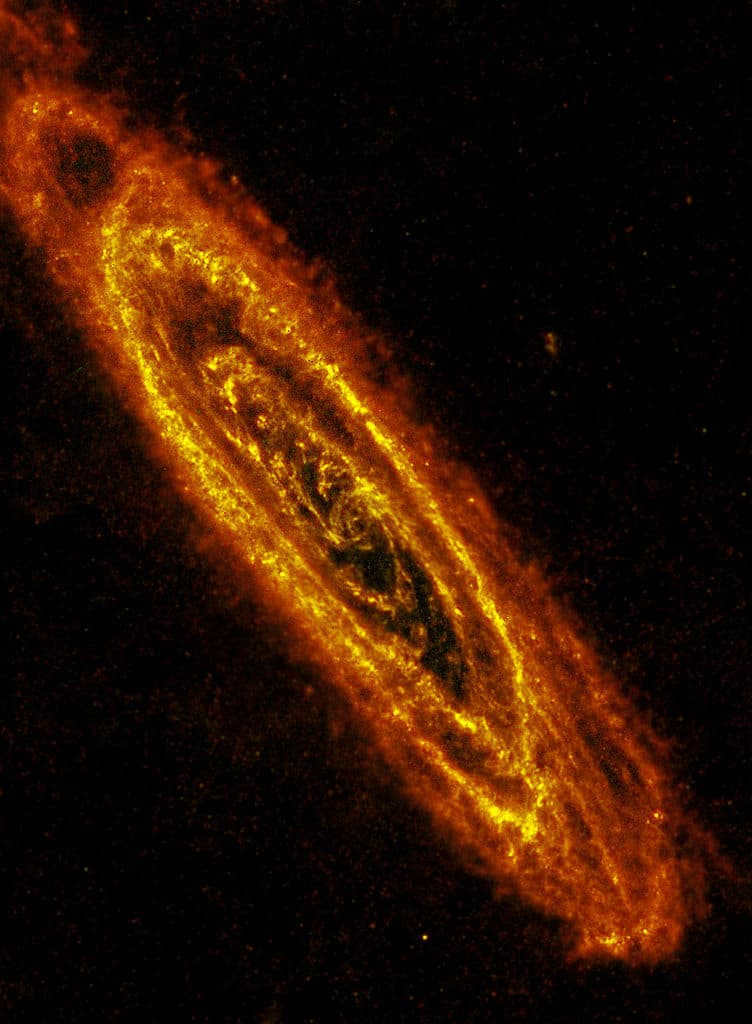
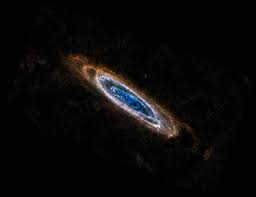
The Andromeda Galaxy (also known as M 31, NGC 224, Andromeda Nebula) is a spiral galaxy of the Sb type and is the biggest galaxy in the Local Group. It is the nearest large galaxy to the Milky Way and is situated in the Andromeda constellation, approximately 2.52 million light-years away from Earth.
This galaxy contains around 1 trillion stars, which makes it 2.5 to 5 times larger than the Milky Way. Additionally, it is more than twice the size of our galaxy. The virial mass of the Andromeda Galaxy is estimated to be about 800 billion solar masses.
The Andromeda Galaxy is tilted at a 15° angle relative to the line of sight, and appears to be 3.2 × 1.0° in size. Its apparent magnitude is +3.4 m. The earliest record of the galaxy is found in the “Catalog of Fixed Stars” by al-Sufi, who referred to it as a “small cloud”. The first telescopic observation of the Andromeda Galaxy was made by Simon Marius in 1612. Charles Messier mistakenly credited Marius with its discovery when he included it in his famous catalog as M 31. In 1785, William Herschel observed a faint red spot at the center of M 31. He incorrectly believed that the galaxy was the closest nebula and calculated its distance to be equivalent to 2000 times the distance between the Sun and Sirius.
In 1864, William Huggins made an observation of the spectrum of M 31 and discovered that it differed from the spectra of gas-dust nebulae. The data indicated that M 31 was actually composed of numerous individual stars. Based on this finding, Huggins put forward the hypothesis that the object was a stellar entity, which was subsequently proven correct in the years that followed.
In 1885, a supernova known as SN 1885A, or S Andromeda in astronomical literature, occurred in the galaxy. This remains the only recorded event of its kind in the history of observations of M 31.
The initial photographs of the galaxy were acquired by Welsh astronomer Isaac Roberts in 1887. Utilizing his own modest observatory in Sussex, he captured images of M 31 and was the first to identify the spiral structure of the object. However, at that time, it was still believed that M31 was part of our own Galaxy, and Roberts mistakenly believed it to be a separate solar system with developing planets.
The galaxy’s radial velocity was determined by American astronomer Vesto Slifer in 1912. Through spectral analysis, he calculated that M 31 is moving towards the Sun at an unprecedented speed for known astronomical objects of that era: approximately 300 km/s.
General Characteristics [ ]
Motion in the Local Group [ ]
Main article: Milky Way and Andromeda Galaxy collision
The Andromeda Galaxy, similar to the Milky Way, is a member of the Local Group and is currently moving towards the Sun at a velocity of 300 km/s. This means that it is classified as having a violet shift. Scientists have determined that the Andromeda Galaxy and our own Galaxy are heading towards each other at a speed of 100-140 km/s by studying the direction of the Sun’s motion within the Milky Way. As a result, a collision between these two galactic systems is expected to occur in approximately 3-4 billion years. If this collision does occur, it is likely that the two galaxies will merge into one larger galaxy. There is a possibility that our solar system may be flung into intergalactic space due to the powerful gravitational disturbances caused by this merger. However, it is unlikely that the destruction of the Sun and planets will occur during this process.
Based on data published in September 2014, it is projected that in approximately 4 billion years, the Milky Way will assimilate the Large and Small Magellanic Clouds, and in 5 billion years, it will itself be absorbed by the Andromeda Nebula. Other estimations suggest that the galaxies will tangentially collide in about 4.5 billion years.
Researchers from the University of Michigan, specializing in astrophysics, have conducted calculations indicating that a significant portion of the surrounding stellar halo of the Andromeda galaxy originates from a singular massive galaxy, known as M 32p. This galaxy collided with the Andromeda galaxy approximately 2 billion years ago, and the remnants of this deceased galaxy are now orbiting around the Andromeda galaxy, existing as the satellite galaxy M 32.
The Gemini Observatory and Keck Observatory have examined the peculiar movement of the GC-Non and GC-Sub stellar clusters, which were found by the Canada-France-Hawaii telescope in the Andromeda halo as a component of the Pan-Andromeda Archaeological Survey [en]. By projecting their motion back in time, it has been possible to uncover evidence of two distinct instances of collision, one occurring approximately 7 to 10 billion years ago and the other taking place within the past few billion years.
Structure [ ]
The Local Group’s largest galaxy, known as the Andromeda Galaxy, is believed to be home to approximately one trillion stars, according to astronomers’ calculations using data from the Spitzer Space Telescope. In addition to its vast number of stars, Andromeda also boasts a number of dwarf satellite galaxies, including M 32, M 110, NGC 185, NGC 147, and potentially others. Spanning a width of 220,000 light-years, this colossal galaxy is 2.2 times larger than our very own Milky Way.
Central [ ]
At the center of M 31 like numerous other galaxies (including our own Milky Way), there exists a potential supermassive black hole (SSH). Scientific computations have indicated that its mass surpasses 140 million times that of the Sun. In 2005, the Hubble Space Telescope observed an enigmatic disk composed of youthful blue stars encircling the SFD. These stars revolve around the relativistic object, much like planets orbiting the Sun. Astronomers were perplexed by how such a torus-shaped disk could have developed in such close proximity to such a colossal entity. According to calculations, the immense tidal forces of the NFD should prohibit the condensation of gas and dust clouds, and the subsequent formation of new stars. Additional observations may yield valuable insights.
During their observation of the central region M 31 using the XMM-Newton space telescope, a group of European scientists made an intriguing discovery. They detected a total of 63 distinct X-ray sources in the area. Upon further analysis, it was determined that the majority of these sources (specifically 46 of them) are associated with low-mass binary X-ray stars. However, the remaining sources are believed to be either neutron stars or potential black holes in binary systems.
Other celestial bodies. The galaxy has a record of approximately 460 globular clusters. The largest among them, known as Mayall II or G1, possesses the highest luminosity in the Local Group, surpassing even the brightest cluster in the Milky Way – Omega Centauri. Positioned around 130,000 light-years away from the core of the Andromeda Galaxy, Mayall II is home to at least 300,000 aged stars. Its composition, along with the presence of stars from various populations, suggests that it is likely the core of an ancient dwarf galaxy that was assimilated by the M31. Recent studies indicate that there might be a black hole candidate with a mass equivalent to 20,000 Suns at the heart of this cluster. Similar celestial bodies are also present in other clusters. [ ]
In 2005, a discovery was made by astronomers in the halo of M 31. The halo of M 31 contains three clusters that have recently been found to harbor hundreds of thousands of bright stars, which is nearly equivalent to the number of stars found in globular clusters. However, what distinguishes these clusters from globular clusters is their larger size, spanning several hundred light-years, and their lower mass. Furthermore, the distances between the stars within these clusters are significantly greater. These clusters may represent a class of systems that bridge the gap between globular clusters and dwarf spheroidal galaxies.
Within this galaxy, there exists a star called PA-99-N2, which is orbited by an exoplanet. This exoplanet is notable for being the first to be discovered outside of the Milky Way.
Research published in June 2013 reveals that there are at least 35 black holes in this galaxy, which is a much larger number than previously believed and surpasses the count of black holes in our own Galaxy.
The standard astronomical system indicates that the rotation axis of Andromeda’s stellar disk is aligned at an angle of 128°. Furthermore, the GC-Non cluster subgroup exhibits a projected angular momentum vector aligned at approximately 84°, while the GC-Sub subgroup showcases an alignment of approximately 170° in the standard astronomical coordinate system.
Satellite galaxies [ ]
Main article: List of satellite galaxies of the Andromeda Galaxy
Similar to our Milky Way, the Andromeda Galaxy is surrounded by a number of dwarf galaxies – small stellar systems comprising a few billion stars. The most prominent among these are the compact elliptical galaxies M 32 and M 110, which can be seen in any photograph of the Andromeda Galaxy. Calculations suggest that M 32 may have had spiral arms in the recent past, but the formation of these arms was hindered by the strong tidal forces exerted by the Andromeda Galaxy.
After years of studying the Canada-France-Hawaii telescope, a remarkable finding was made: a complete cluster of dwarf galaxies all orbiting in the same plane around the majestic M 31. This groundbreaking discovery was officially published in early 2013.

Andromeda Galaxy is positioned in the Andromeda constellation. It has a radius of approximately 31 kiloparsecs, although its visible dimension from Earth is similar to that of the Moon.
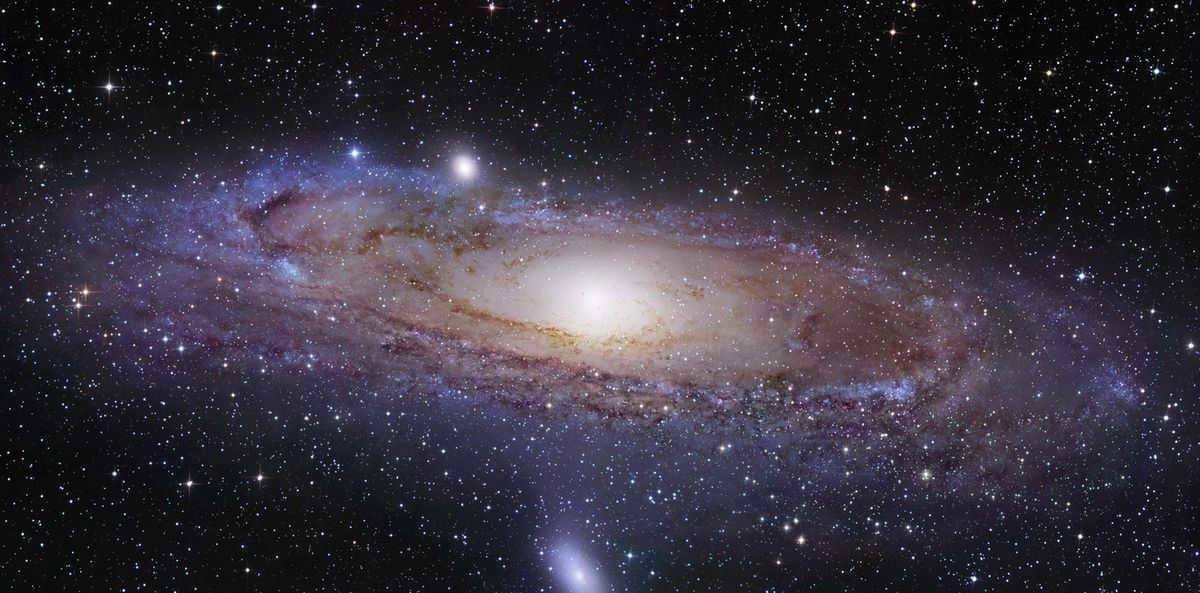
The galaxy is categorized as a local group object due to its distance of approximately 800 kiloparsecs.
Physical Characteristics
Descriptions:
The Andromeda Galaxy features a distinct spherical subsystem and a disk with clearly visible spiral arms.
The spherical subsystem refers to the spherical symmetry and rapid thickening towards the central region found in spherical galaxies.
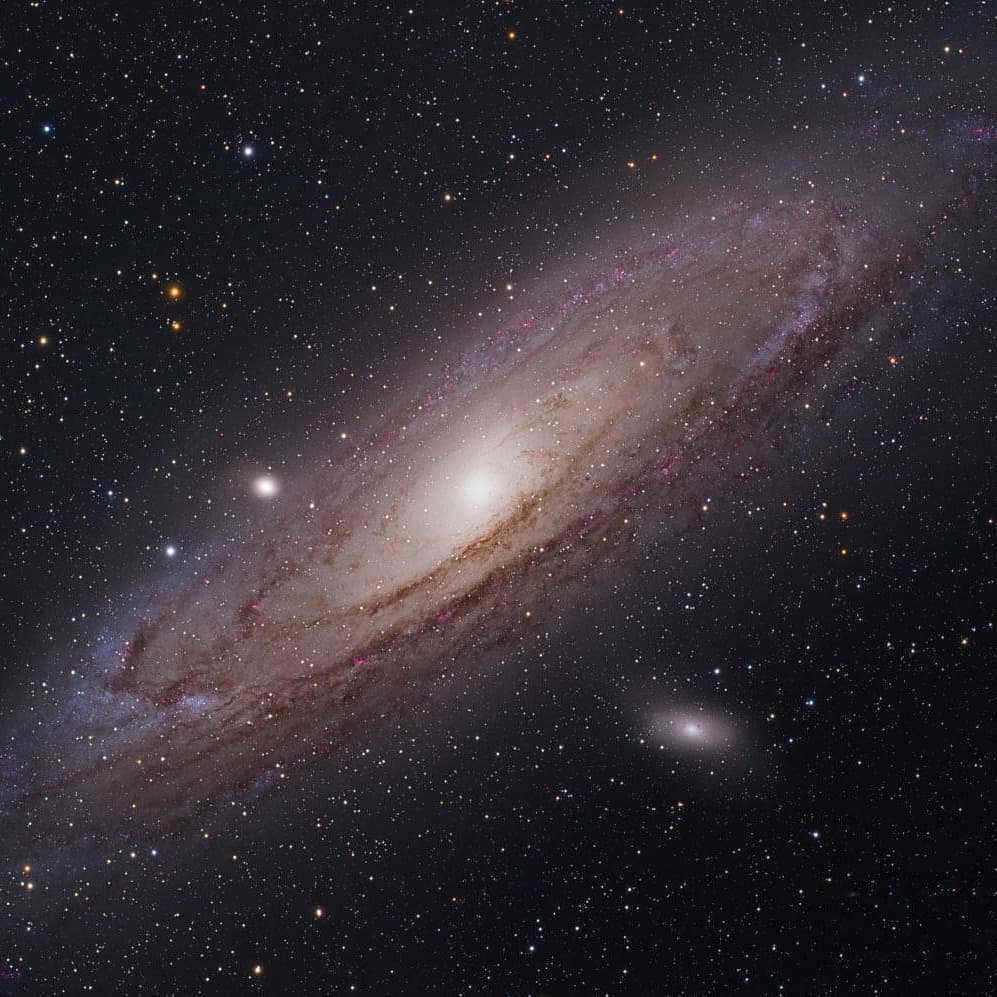
Usually, the spherical component is made up of a consolidation of stars in the galaxy’s core (known as a balge), dark matter, globular clusters, and short-lived cepheids (stars that pulsate and show changes in brightness).
The spherical component serves as a sort of foundation for the galaxy’s structure.
The disk has a slightly curved shape and features a ring with a radius of approximately 10 kiloparsecs. This ring contains regions of ionized hydrogen (H II regions) where stars are formed, as well as associations of loosely bound stars (OB associations).
The halo and balge are flattened, and although the bar cannot be observed directly, there are indications of its existence.
- Balge – A concentration of stars found at the center of a galaxy.
- The bar – is a stretched out “chain” of stars composed of gas located at the core of the galaxy. It is occasionally referred to as a “link”.
- The halo – The imperceptible majority of the circular subsystem. Expands beyond the observable segment of the galaxy and is comprised of gas, dark matter, and stars.
Mass distribution and composition
With its immense size, the Andromeda Galaxy stands as the dominant galactic force within the Local Group. Recent observations made by the Spitzer telescope estimate that this galaxy is home to a staggering one trillion stars.
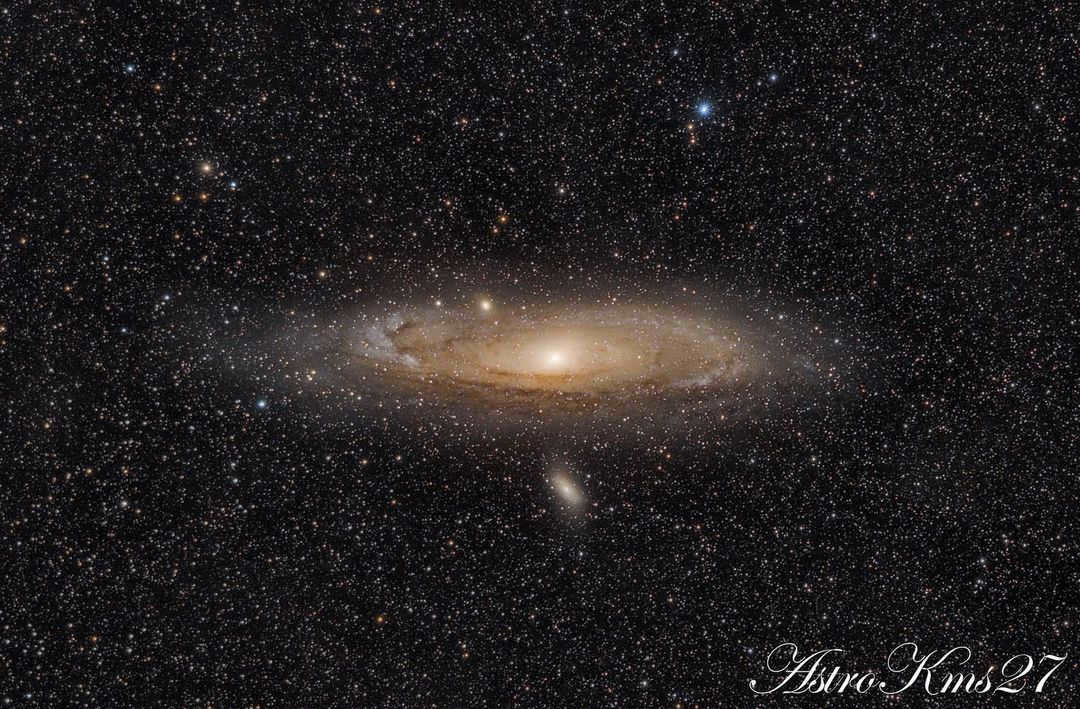
The Andromeda Galaxy’s Disk: An Intricate Structure
The disk encompasses 56% of the galaxy’s stellar mass and contributes to 70% of its luminosity. The outer regions of the disk host the youngest stars, which emit a bluish light due to their high temperatures. The central regions of the disk contain spiral arms, highlighted by dust clouds in the inner part and supergiants and H II regions in the outer part.
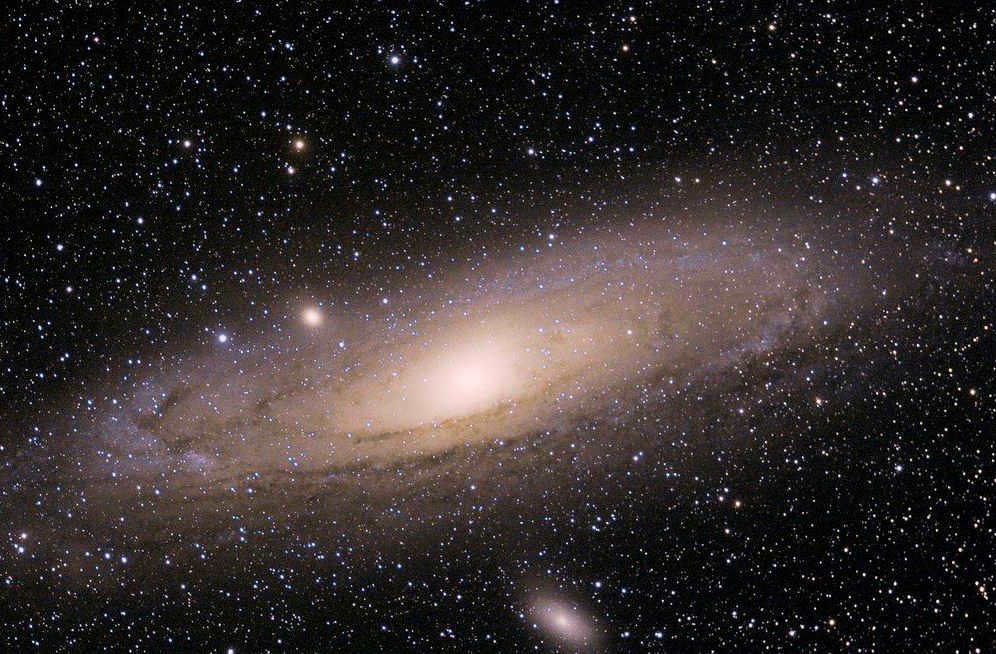
Spherical component
The spherical component contributes to 30% of the galaxy’s brightness. The bulge contains 30% of the total stellar mass, while the halo accounts for 13%.
There is a possibility that M 31 possesses a bar, but if it does, it is aligned nearly parallel to the line of sight, which explains why it has remained undetected until now.
The central core
NGS 224 possesses a unique dual core. The two most prominent areas, P1 and P2, are situated in the heart of the galaxy, with a separation of 1.8 parsecs. P2 is closer to the central region, but P1 shines brighter. The visible magnitude of the star in the V band is 12.6m, indicating an absolute magnitude of -12.0m.
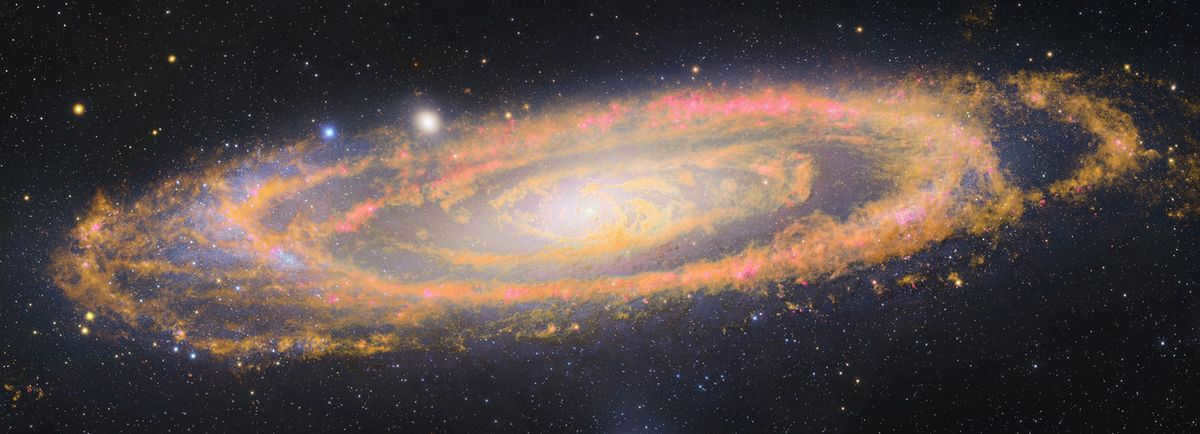
The dual nature of the nucleus may be attributed to NGS 224 absorbing a globular cluster or a smaller galaxy during its early formation stages, or due to a portion of the singular massive nucleus being obscured by dust, giving the appearance of a dual nucleus.
Incidentally, the nucleus possesses an immense luminosity, 60 times greater than the average luminosity of globular clusters in the galaxy, and it also serves as a radio source with a luminosity 30 times fainter than that of the Milky Way.
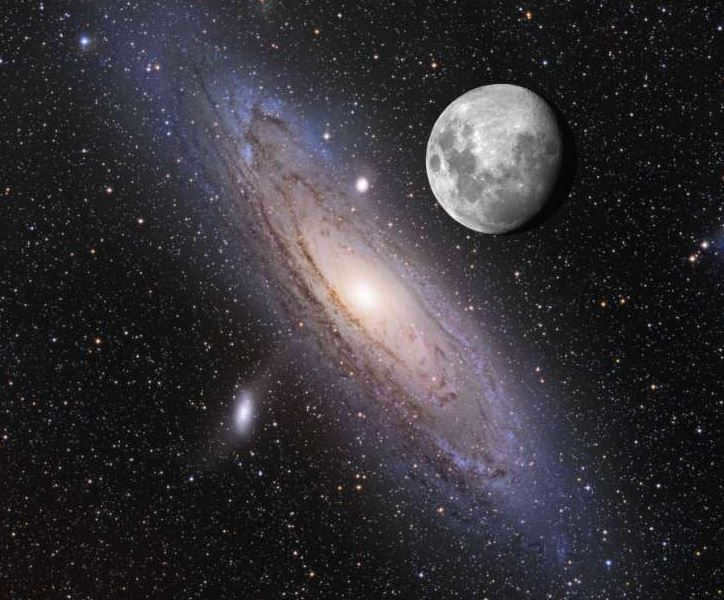
Located at the core’s center is a potential supermassive black hole, with a mass surpassing 140 million times that of the sun. However, a surprising discovery was made nearby: a disk of youthful blue stars, which was not anticipated.
The presence of a supermassive black hole typically distorts gravitational forces, preventing the formation of gas and dust clouds necessary for the creation of stellar nuclei and stars.
Please note: these distortions caused by gravity are known as tidal forces.
Currently, scientists are actively searching for an explanation for this phenomenon. It is hoped that further observations of the galaxy will provide some insight.
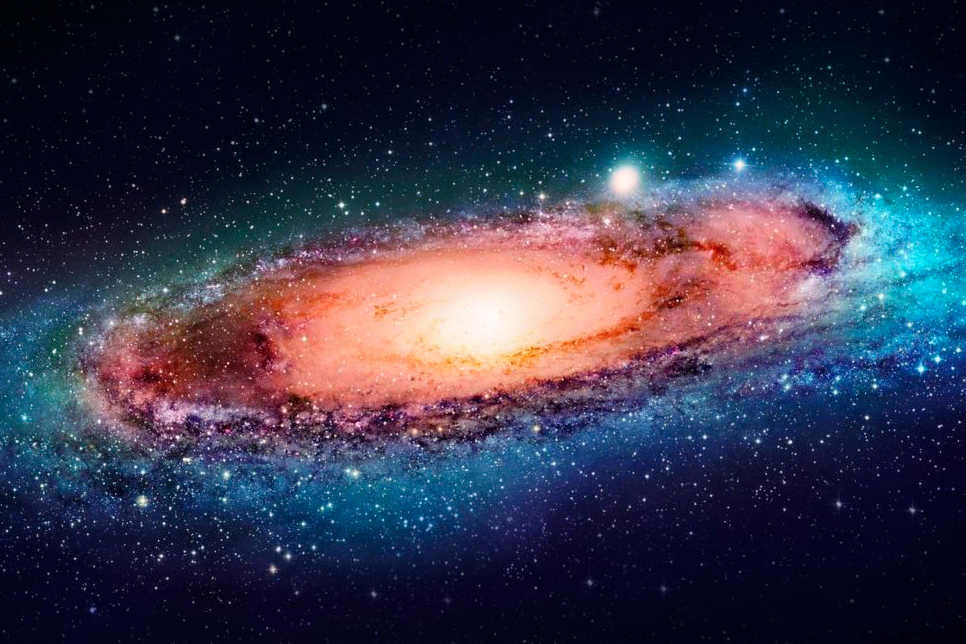
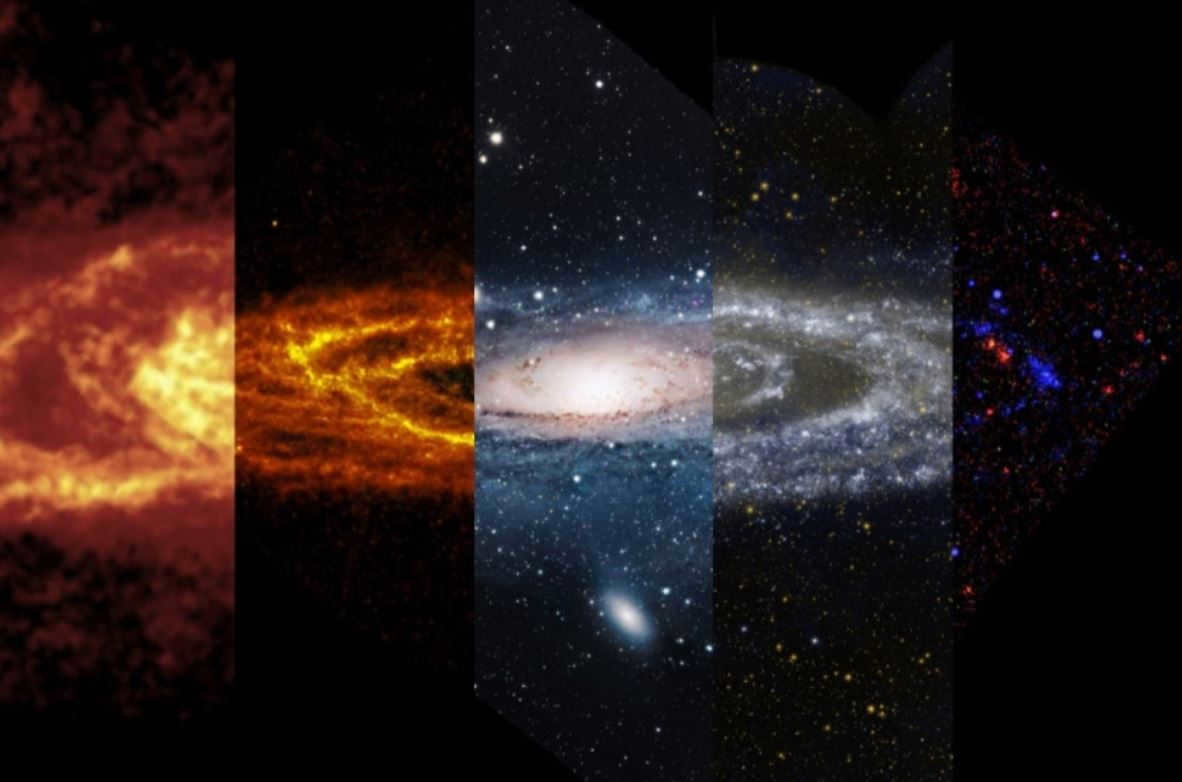
The classical balge stars are the primary inhabitants of the central regions of the galaxy. These stars have an increased level of metallicity and a higher content of alpha elements compared to iron. As we move further away from the center, the metallicity gradually decreases, but there may be an increase in the intensity of the alpha process.
The alpha process is a nuclear reaction that involves the capture of alpha particles by light nuclei. It is through this process that stars synthesize all chemical elements ranging from helium to nickel.
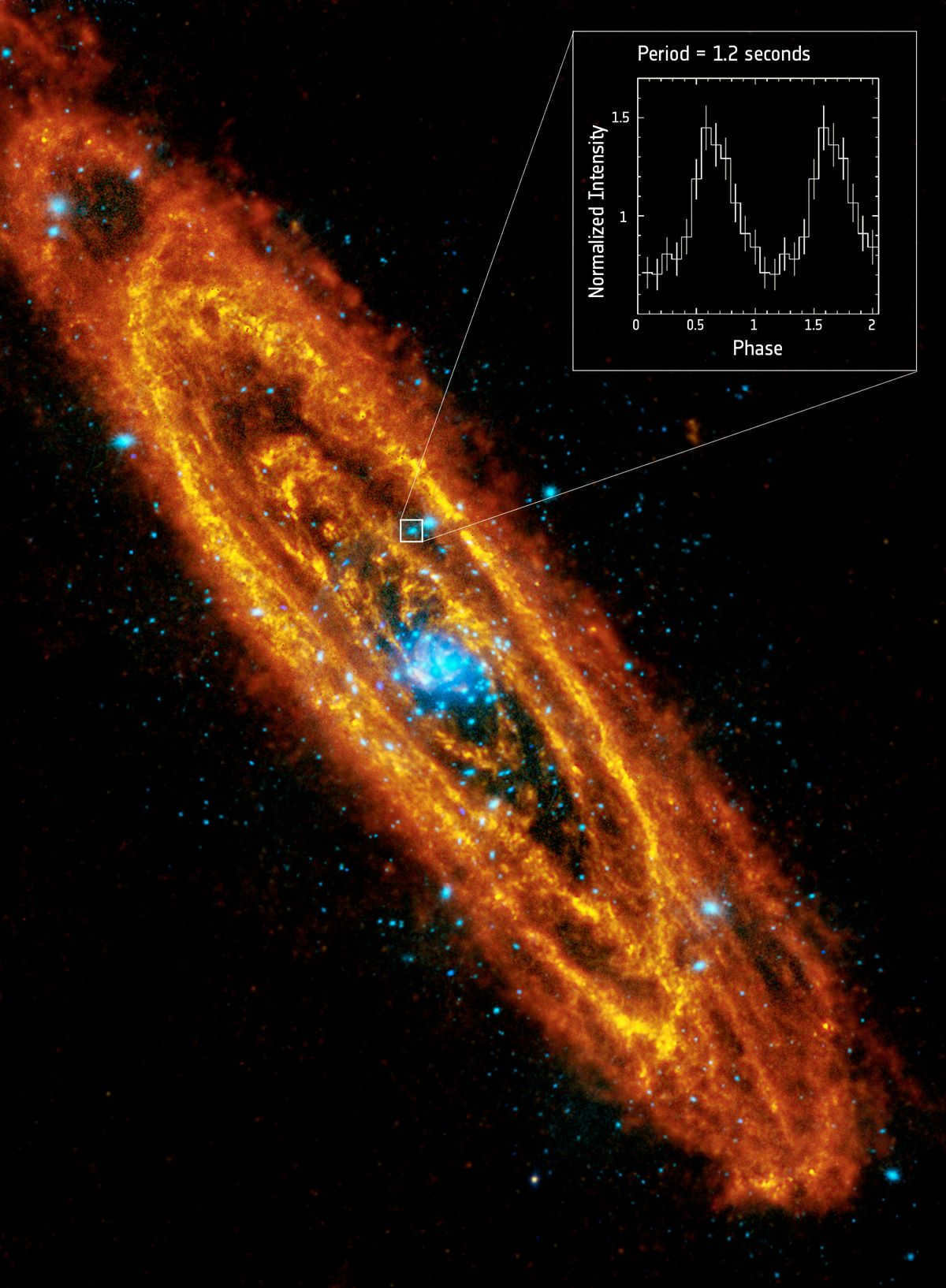
The Lintel stars exhibit a higher concentration of alpha elements, although their metallicity closely resembles that of the Sun.
Within the halo, there is also a noticeable decrease in metallicity towards the outer regions, and the distribution of metallicity can be observed within tidal structures as well.
The current rate of star formation in the Andromeda Galaxy is only 20-30% of that in the Milky Way. Additionally, the stars in NGS 224 are significantly older than those in our own galaxy.
Typically, the age of stars can be categorized into three ranges: the first range spans between 100 and 500 million years, the second range encompasses approximately 5 billion years, and the third range encompasses 10-12 billion years.
Within the confines of the Milky Way, globular clusters possess an approximate age of 10-11 billion years, devoid of any youthful stars.
M 31 boasts an exceedingly prominent globular cluster system; a total of approximately 400 globular clusters are present, with estimations suggesting a count of 450. It is plausible that this multitude of clusters with varying ages arose from the scenario in which the galaxy assimilated smaller systems in its past.
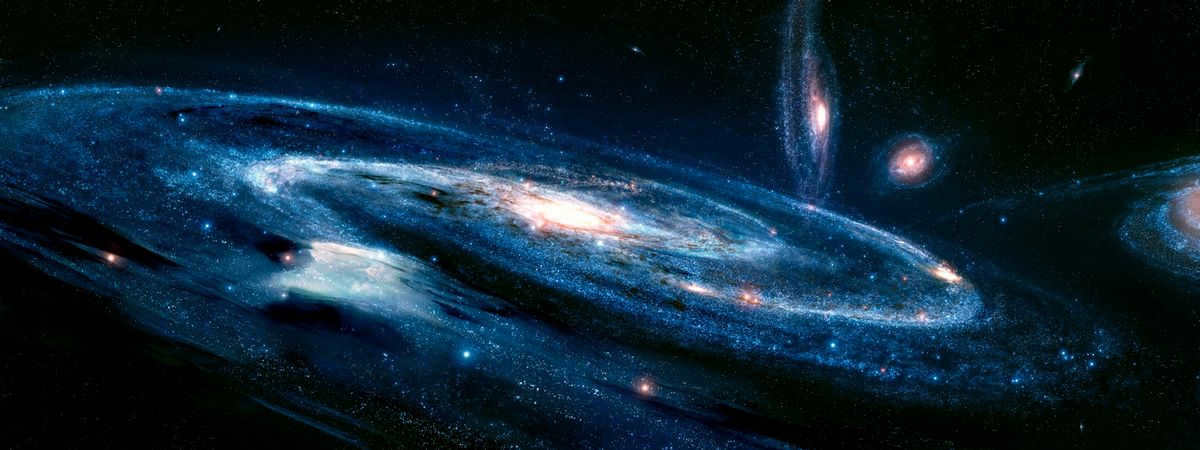
The interstellar medium of the Andromeda Galaxy is composed of various temperatures of gas and dust. The galaxy contains approximately 4⋅109 M⊙ of atomic hydrogen and 5⋅107 M⊙ of dust. This significant amount of dust has the potential to create shadows and could potentially impact astronomical observations within the galaxy.
Dust particles also play a role in light absorption and reddening. Within the Andromeda Galaxy, there are approximately 700 individual dust clouds that contribute to this effect.
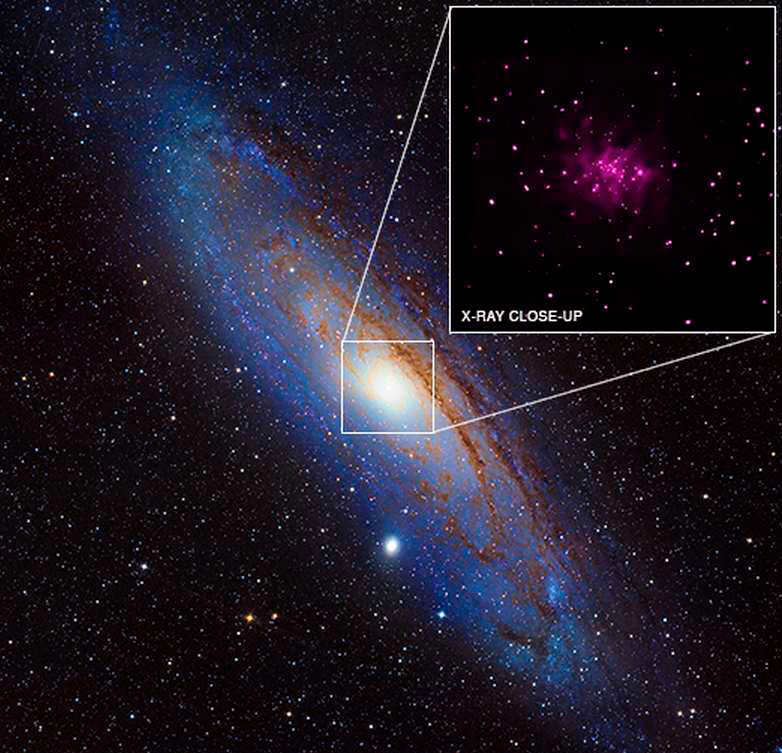
The Andromeda galaxy is home to a vast array of celestial objects. According to preliminary estimates, there are over 4200 planetary nebulae in this galaxy, although this number could be as high as 8000. Additionally, there are 3900 H II regions, 26 supernova remnants, and 20 unidentified objects that may belong to these categories.
One notable feature of M 31 is the presence of molecular clouds emitting radiation from CO. These clouds are most active in the spiral arms and have masses of approximately 10^6 M⊙, while the inter-arm clouds have masses around 10^4 M⊙.
In addition to these findings, NGS 224 boasts a population of approximately 800 new stars, with an average of 50 new stars being discovered each year. There are also 35,000 variable stars and at least 1,897 radio sources, some of which exhibit variability.
A potential exoplanet, known as PA-99-N2b, has been identified within the Andromeda galaxy.
Observations of the nighttime heavens
The Andromeda Galaxy can be found in close proximity to the constellation Andromeda. To locate it, one must trace an imaginary line that intersects the star Mu Andromeda and Mirach. The Andromeda Galaxy will be situated along this line, positioned amidst the constellations of Pegasus, Andromeda, and Cassiopeia.
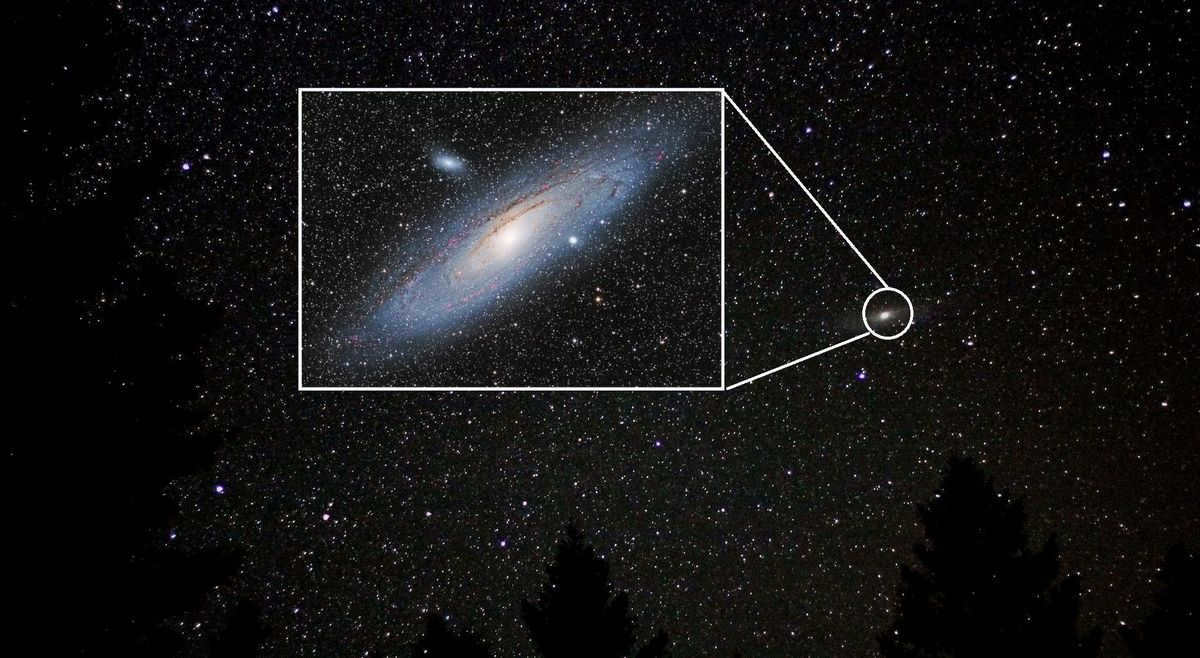
The origin of the galaxy
NGS 224 came into existence approximately 10 billion years ago as a result of the collision of multiple galaxies. Another collision occurred 8 billion years ago, causing Andromeda to transform into a luminous infrared galaxy for the following 100 million years and experience active star formation.
The next episode of star formation and the distortion of the disk took place 2-4 billion years ago when Andromeda collided with the Triangle Galaxy.
Around 100 million years ago, NGS 224 absorbed another small galaxy, leading to the formation of a gas disk that rotates in the opposite direction to the rotation of M 31.
Frequently Asked Questions
What is the correct term, “Andromeda Nebula” or “Andromeda Galaxy”? I came across a book titled “nebula” but it was discussing a galaxy!
Officially, the accurate designation is Andromeda Galaxy, as a galaxy and a nebula are distinct entities. However, this distinction did not deter Ivan Efremov from naming his book “The Andromeda Nebula”.
In the earliest surviving reference, dating back to 964 AD, the astronomer As-Sufi referred to it as a “little cloud”.
I am new to astronomical observation, how can I simplify the process of locating a galaxy in the night sky?
You can try using a mobile star map, seek advice on a forum, or utilize the planetarium program Stellarium, which is also accessible in its web version.
Indeed, based on initial calculations, this event is anticipated to occur in approximately 4 billion years. This impending collision will also encompass the Triangle galaxy, potentially causing the Milky Way to collide with it prior to its collision with Andromeda.
Undoubtedly, among the most luminous companions are M 32 and M 110. All in all, Andromeda boasts an approximate total of 30 companion galaxies, and it is conceivable that the engulfed Triangle galaxy may be one of them.
The Andromeda Galaxy, also known as the Andromeda Nebula, is an immense celestial body consisting of a trillion stars. It is a galaxy of greater size than our own Milky Way and holds the distinction of being the nearest galaxy to us. The Andromeda Galaxy can even be observed with the naked eye due to its hazy appearance in the sky.
Within the realm of neighboring galaxies, the Andromeda Galaxy is a member of the Local Group, with the added distinction of being the closest of them all. Although the term “close” is relative, considering its distance of 2.5 million light years away. Thus, when gazing upon this cosmic entity, one is actually observing it as it appeared 2.5 million years in the past. It is from this vantage point that our own galaxy can be seen, with our human ancestors just beginning to walk upright on their hind legs!
What is the galaxy M31
The galaxy M31 is a stunning and awe-inspiring celestial object that you may have come across in various images. Due to its immense size and relatively close proximity compared to other galaxies, it appears incredibly impressive. However, our perspective of M31 is slightly skewed as we observe it at an angle of only 15 degrees, resulting in its oval-like appearance. In reality, M31 is an enormous spiral galaxy, similar to our very own Milky Way. While they share many similarities, they also possess numerous distinguishing characteristics.
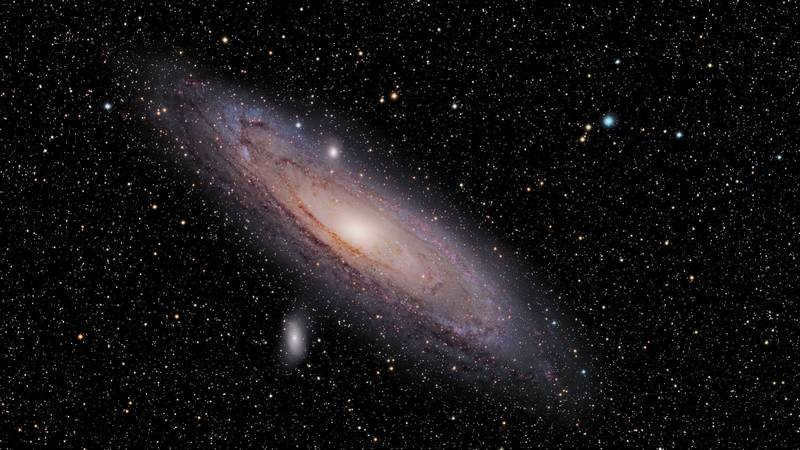
The Andromeda Galaxy is home to a trillion stars, which is several times more than the Milky Way. It is also 2.6 times larger in size, with a cross-section that takes 260,000 years for light to traverse from one edge to the other. This massive celestial object is currently moving towards us at a speed of approximately 300 km/s, and it is estimated that in 5 billion years, our galaxies will collide.
The structure of the Andromeda Galaxy follows the typical pattern of spiral galaxies, which is the same category that our own galaxy falls into.
The core of the Andromeda galaxy
Located at the heart of the galaxy is a core, housing a supermassive black hole with a mass exceeding 140 million times that of our sun. Just 1 light year away from this black hole, young blue stars, whose origins remain a mystery, orbit like planets. These stars are a mere 200 million years old.
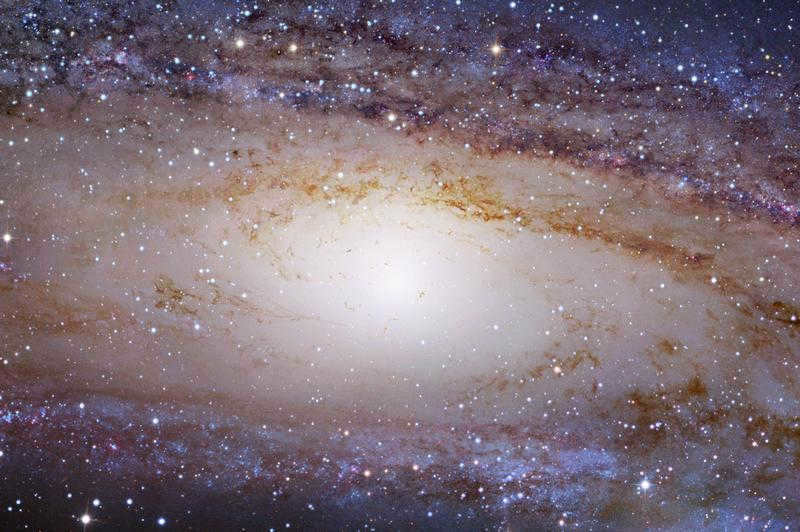
It is impossible for gas nebulae to form near the black hole, where stars could potentially emerge. The immense mass of the black hole prevents hydrogen from gathering and collapsing into a protostar. Nevertheless, there is a cluster of 400 young stars in this region. Towards the center of the cluster, there are also old red stars that move at an astonishing speed of 1000 km/s in their orbits.
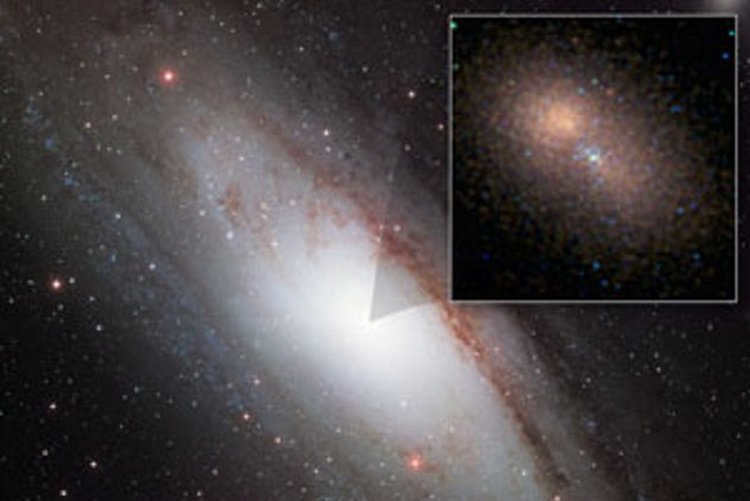
The close-up view of the nucleus of M31.
Located 5 light-years away from the center, beyond the cluster of young stars, lies a ring comprised of aged, red stars. Within this small region, several hundred stars, including the supermassive black hole, are concentrated. Additionally, remnants such as neutron stars and potential black holes can be found.
Therefore, the core of the Andromeda galaxy is a densely populated area housing various celestial objects, making it an inhospitable and perilous location.
The Marvels of M31
Aside from its central core, the Andromeda Nebula boasts a plethora of captivating entities. One notable discovery is the presence of a novel class of star clusters. These clusters bear resemblance to globular clusters, albeit on a grander scale – their diameter spans hundreds of light-years. In addition, they contain hundreds of thousands of stars, yet they are not as densely packed as their more compact counterparts. Scientists are inclined to classify these enigmatic structures as dwarf spheroidal galaxies.
Can you fathom the notion? A colossal galaxy harboring its very own dwarf galaxies within. Although these minuscule galaxies are still incredibly massive by our standards, their true proportions are mind-bogglingly difficult to conceive.
M31 is home to the most brilliant globular cluster among all the galaxies in the Local Group. This cluster, known as Mayall II, is situated 130,000 light-years away from the galaxy’s center. It consists of a minimum of 300,000 ancient stars, and at its core lies a black hole with a mass equivalent to 20,000 times that of our Sun. Scientists hypothesize that this globular cluster originated from the central region of a dwarf galaxy that was assimilated in the past, and it now exists as a mere constituent of a colossal metropolis.
Within this galaxy, there have been 35 black holes identified so far. Moreover, there are approximately 450 globular clusters, which is half the number found in our own Milky Way. It is plausible that there are many more, but the study of the distant outskirts presents considerable challenges.
Within our galaxy, the Milky Way, there exist smaller satellite galaxies known as the Large and Small Magellanic Clouds. Similarly, the Andromeda Galaxy contains its own collection of satellite galaxies, with M32 and M110 being the most prominent and sizable among them, easily distinguishable in photographs. While there are numerous satellites in total, they tend to be relatively diminutive in size.
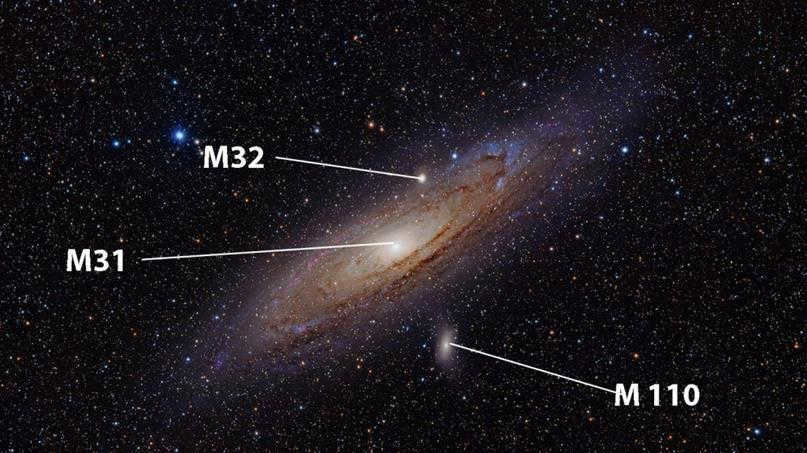

The primary satellite galaxies of the Andromeda Galaxy.
The origin of M32 remains uncertain. Scientists speculate that it was once a massive spiral galaxy that was almost engulfed by the Andromeda Galaxy about 2 billion years ago. The shapeless formation we observe today is the remnants of a galaxy twisted by the immense gravitational forces of a trillion-year-old celestial body. Its stars were dispersed across a vast expanse of space and now compose the halo surrounding M31, its outskirts.
M110 likely experienced a similar fate. Numerous stars found between this galaxy and the Andromeda Nebula also exist in M110. These stars are abundant in heavy elements and continually traverse between galaxies.
The Andromeda Galaxy: A Celestial Marvel
What makes the Andromeda Galaxy truly remarkable is its visibility to the naked eye. With keen eyesight, one can easily spot this starry oasis in the night sky, appearing as a slightly fuzzy and indistinct glow with a brightness of 3.44m. It’s fascinating to note that this galaxy spans an area that is seven times larger than the Moon’s disk in the sky. However, due to its low surface brightness, we can only perceive the radiant core. For a more detailed observation, binoculars or a telescope are recommended.
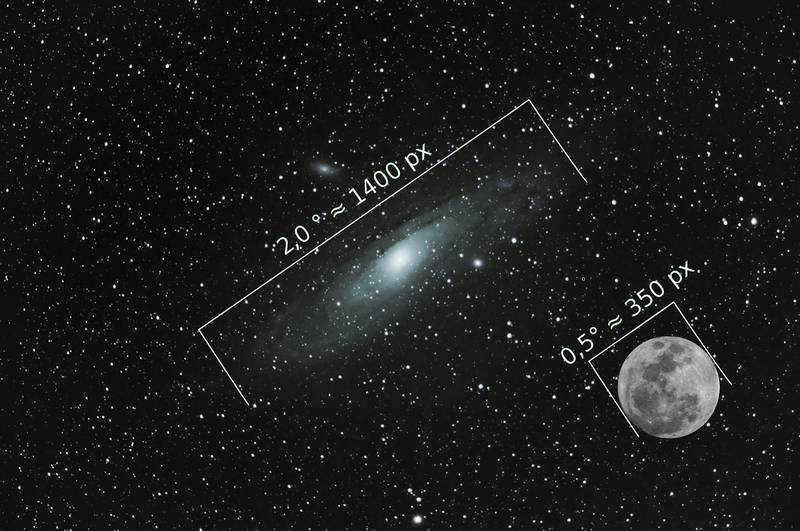

When it comes to the sky, the Andromeda galaxy and the Moon occupy separate areas. It is interesting to note that the Andromeda galaxy is actually bigger than the Moon!
To locate the Andromeda galaxy in the sky, you need to look towards the south. You can spot the Great Rectangle of Pegasus, which consists of four relatively bright stars. On the left side of this rectangle, there is a row of bright stars that form the constellation Andromeda. If you imagine a triangle with the second and third stars as its points, you will notice a hazy spot at the top – that is the Andromeda Galaxy. It is easily visible on a dark night and resembles a cloud, so it’s definitely worth looking in that direction.
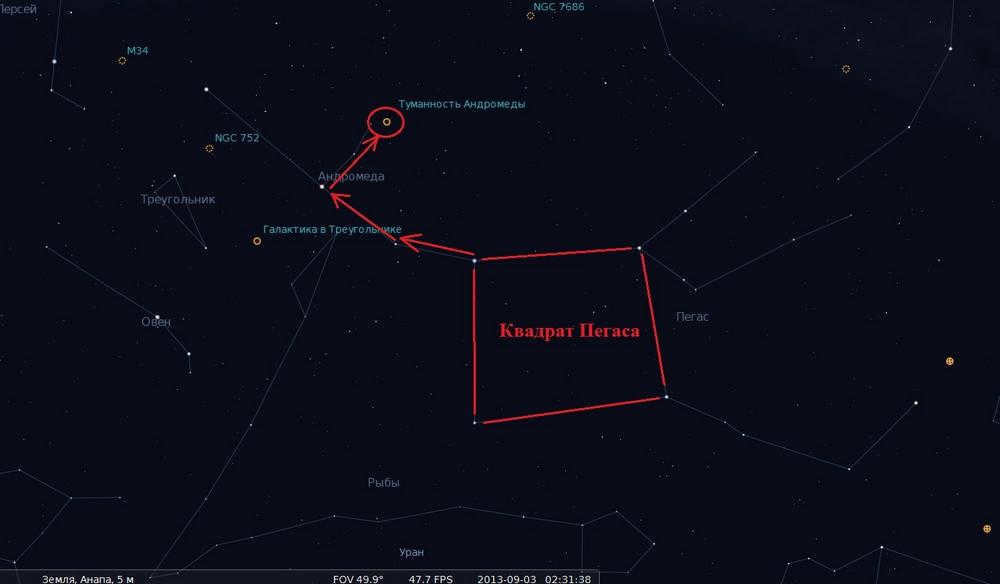
How to locate the Andromeda Galaxy in the night sky.
If you’re having trouble spotting the Pegasus Square, you can visualize a line connecting Polaris to Alpha Cassiopeia and extend it – the line will terminate at the exact corner of the Square you’re looking for. So now you have a grasp of the method for finding the Andromeda galaxy in the night sky. However, if you desire a clearer view, equip yourself with binoculars, although you won’t be able to discern much detail. The galaxy’s disk can only be observed through a powerful telescope.
Observing the Andromeda Galaxy
When looking at the Andromeda Galaxy with the naked eye, it may seem like a small, blurry spot in the sky. However, if you focus your gaze on this particular area, you might catch a glimpse of something ethereal.
Using binoculars to observe the Andromeda Galaxy doesn’t reveal much more detail. Nevertheless, you can already make out its general shape. With 10×50 binoculars, you can see that it appears elongated, with a thinner middle and thicker arms. If you look closely, you can also spot the companion galaxy M110, and with some effort, even M32.
Observing the Andromeda galaxy is greatly enhanced by using a larger aperture telescope. While high magnification is not necessary, as the galaxy cannot fit in the field of view even at low magnification, the diameter of the lens and the amount of light collected are crucial. With a 150-mm telescope, one can easily observe the nucleus, large clusters in the galaxy’s disk, and even dark nebulae that cut through it.
The Andromeda galaxy: its discovery and initial observations
The existence of the Andromeda Galaxy has been acknowledged for a significant period. It was first documented by the Persian astronomer al-Sufi in his comprehensive catalog around 946 AD. However, it wasn’t until 1612 that the German astronomer Simon Marius became the first to visually observe it through a telescope. Naturally, given the limitations of the telescopic technology available at that time, Marius was unable to discern intricate details of the galaxy.
Later on, when Charles Messier compiled his renowned catalog of nebular objects, he assigned the Andromeda galaxy the number 31, solidifying its place in astronomical records.
It wasn’t until almost a century later, in 1864, that William Huggins, an English astronomer, proposed that the mysterious nebula was actually composed of multiple stars, based on his spectral studies. And he turned out to be correct.
The first photograph of the Andromeda Galaxy was captured by Isaac Roberts in 1887, revealing its spiral arms. However, at the time, it was still believed to be a galactic object and mistaken for a star surrounded by planets, resembling a protoplanetary disk.
In 1912, American astronomer Vesto Slifer calculated the speed of this peculiar object and arrived at an astonishing result – it was approaching at a velocity of 300 km/sec.
We now know that M31 is a massive galaxy, larger than our own, situated 2.5 million light years away from Earth.
The Milky Way and the Andromeda galaxy are on a collision course.
The Milky Way and the Andromeda Nebula galaxies are both part of the Local Group and are neighbors. What’s more, they are moving towards each other at a speed of 300 km/s. Each galaxy is traveling at a speed of 100-150 km/s, resulting in their rapid convergence.
The gravitational forces exerted by both galaxies are immense, and a distance of 2.5 million light years is relatively short for them. They will reach each other relatively quickly. In 3-4 billion years, the galaxies will come into close proximity, and in 5 billion years, they will merge to form a single galaxy. The exact outcome is unknown, and only computer models exist, but it is certain that a collision between the Milky Way and the Andromeda galaxy will occur.
Nevertheless, throughout its existence, the Andromeda Galaxy has engulfed multiple galaxies, making it significantly larger than our own galaxy in terms of both size and mass. As a result, our Milky Way will undergo significant changes well before the eventual direct collision, thanks to the immense gravitational pull exerted by trillions of suns. This gravitational force will disrupt the galaxy’s structure, causing stars to be ripped from their orbits. Some will be flung out of the galaxy entirely, while others will come dangerously close to colliding with neighboring stars. As a result of these disturbances and gravitational influences, countless planetary systems will inevitably be shuffled, leading to billions of apocalyptic scenarios across different worlds.
Undoubtedly, the Milky Way is not a dwarf either; it bears similarity in mass to the Andromeda galaxy. Consequently, there will also be a plethora of alterations and cataclysms occurring there. However, in due time, after billions of years elapse and the stars in both galaxies assume stable orbits within the novel system, a wholly distinct galaxy will manifest – one that is significantly more massive and expansive. Additionally, it would abound with hydrogen, thereby engendering billions of nascent stars and unexplored planetary realms.
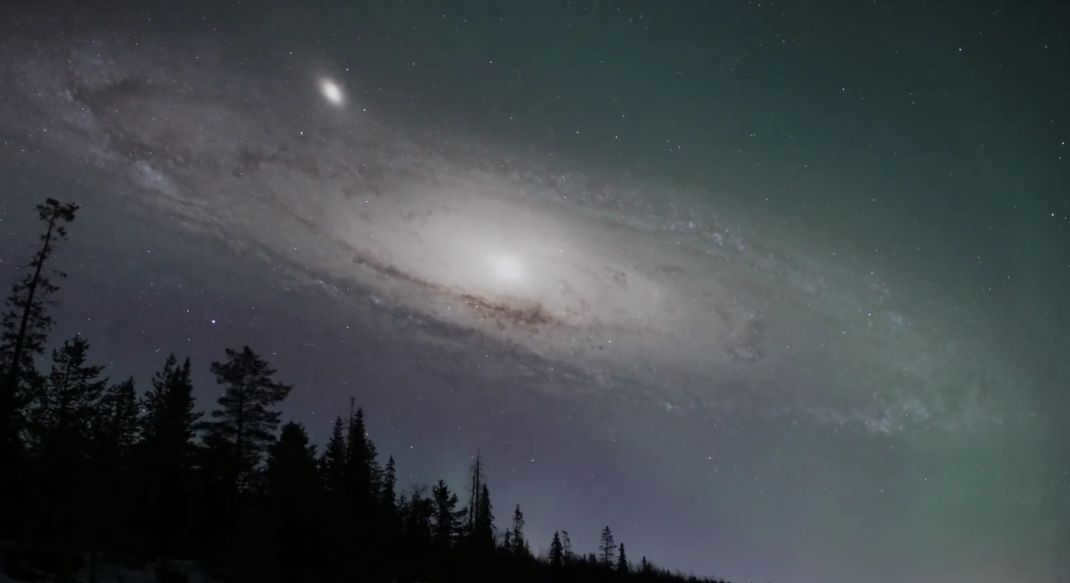
If the Andromeda galaxy were situated in closer proximity, it is possible that at some point in the future, a species similar to ours could emerge.
Naturally, it is highly unlikely that our planet, Earth, will still exist to witness such an event. In approximately 5 billion years, our Sun will undergo a transformation, swelling into a red giant and either scorching or devouring the nearby planets. At best, Earth will be reduced to a charred sphere of rock. The fate of humanity during this time period remains uncertain – either we will have ventured to other star systems or our existence will have come to an end entirely. 5 billion years is an extensive timeframe for the Earth to have evolved and given rise to life.





